Social media can be a hard nut to crack. You’re competing in a crowded space right alongside the biggest brands. But you never know when your newest idea might catch fire and become a social media sensation. We’ve rounded up 10 of the best social media campaign ideas to inspire you while you’re thinking of the next big thing.
Related: How to achieve brand consistency on social media
1. Show your product in action: Nest Cam
Google+ is sometimes left out of the social media circle, but that means you have the opportunity to become a stand-out brand on the platform. Nest, a company that produces advanced thermostats, smoke alarms, and home security cameras, has an enviable Google+ page that can be an example for your brand. Their page in general has a well-branded and visually appealing aesthetic, but one recurring feature is particularly delightful: the #caughtonNestcam videos (Nest Cam is Nest’s home security camera). This one is pretty good:
Here, Nest succeeds in showing their product in action in an engaging and humorous way. Seeing the Nest Cam in a real person’s home makes it easier for a potential customer to picture it in their home. It seems like Nest’s efforts are paying off, too. They have over 12 million Google+ page views and 604k followers.
2. Try a new platform: Oreo + Vines
Have you considered Vine as a social media marketing tool? It’s not the first platform that typically comes to mind, but Vine is a jungle of opportunity (get it?). Oreo caught the Vine vision and used the platform to make videos that, well, made people want to eat more Oreos. These videos also empowered their customers by giving step-by-step tutorials of several different recipes that feature Oreos as an ingredient.
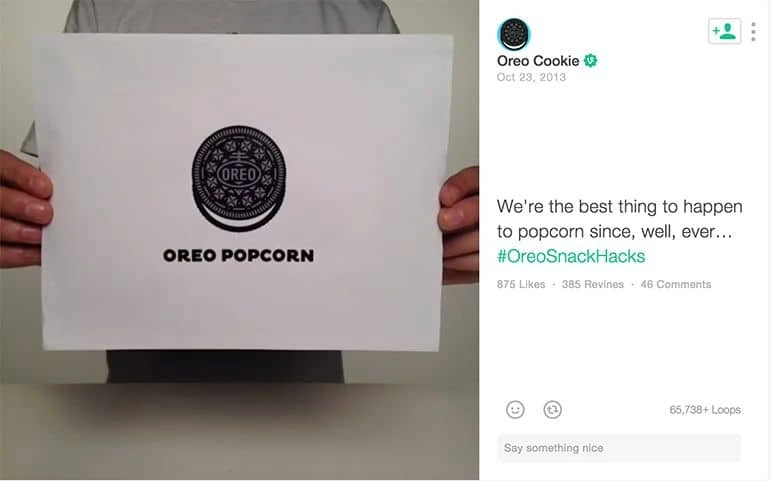
All this has earned Oreo 55.9k followers on Vine and over 3 million video loops. While recipe videos might not fit your brand, how about a product announcement featuring your team wearing lederhosen while yodeling? Or, you know… something like that.
Update: Vine has closed its doors, but the lesson of trying new platforms still stands. For example, has your brand considered Snapchat?
3. Monitor Twitter complaints: #HappyToHelp
Social media can help brands personalize and streamline their customer support, like when a customer tweets about a problem or complaint, and the brand promptly responds with a generous, thoughtful solution.
KLM, an airline operating out of the Netherlands, took this idea to the next level with their #HappyToHelp campaign. During the week of the social media campaign, they set up a control room in front of Amsterdam Schiphol Airport where they monitored thousands of tweets coming in from unhappy airline travelers. They paid special attention to customers having trouble with other airlines. Then they came to the rescue, retrieving forgotten visas, delivering a bed for a stranded traveler, and even singing a lullaby for someone who couldn’t sleep.
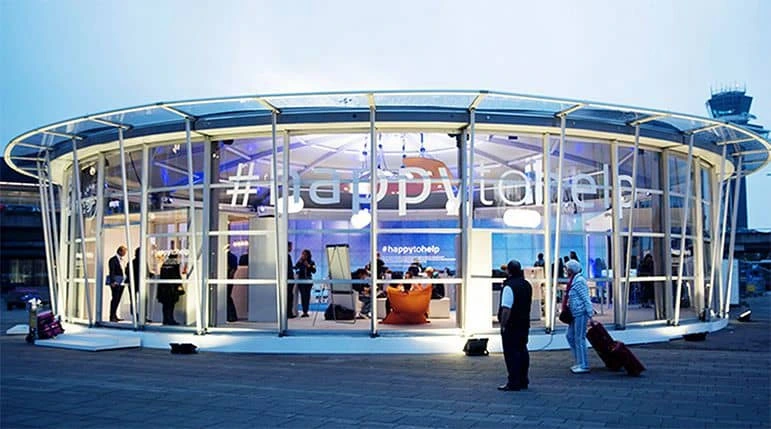
This smart campaign racked up 36 million impressions, and doubtless made a big impression of another kind on the many people who received personalized care from KLM. The genius of #HappyToHelp is that it reached competitors’ customers precisely when they were most dissatisfied with the customer service they were receiving. Monitoring Twitter for problems your customers are having is important, but you might consider checking for problems potential customers are having as well—and then solving them.
4. Make your own news: Pepsi
Pepsi has been around for a while, but that doesn’t stop them from innovating. The Pepsi team launched a social media campaign that caught the attention of London commuters by making it look like crazy things were happening on the street outside the bus stop. Here, just watch the video:
This campaign is interesting because it combines social media with a guerrilla street campaign. Pepsi created news by doing something interesting, and then marketed that news on their social channels. But it was done in a way that felt organic and natural, drawing people to the brand. The bus stop video has accumulated over 7 million views on Youtube in addition to all the people who saw it firsthand on the street.
5. Be helpful to your customers: Hellmann’s
What’s up with WhatsApp? It was the new kid on the social media block, but Facebook bought it for $19 billion, obviously seeing serious potential. Hellman’s (the mayonnaise company) saw that potential too and created a fun, helpful social media campaign centered around WhatsApp.
The campaign centers around a service called WhatsCook that empowers WhatsApp users to make something delicious using the ingredients they have on-hand. Here’s the situation: Angela (not a real person) is hungry. She has a few random ingredients in her refrigerator, but doesn’t know how to put them together. Using WhatsCook through WhatsApp, Angela can send a picture of the ingredients to a real chef who will suggest a recipe idea and then walk her through the cooking process. Pretty cool, right?
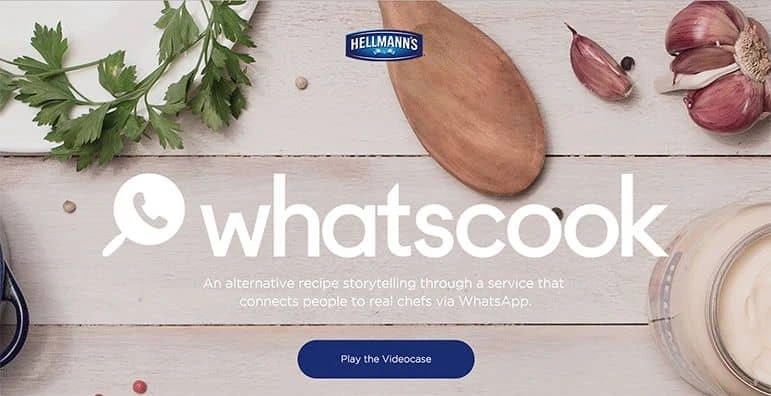
On average, users of the WhatsCook service spent 65 minutes interacting with the chef while they cooked. That’s a lot of time spent with a brand! Hellmann’s made at least two great calls with this campaign. First of all, they found a way that they could be truly helpful to customers and potential customers. There’s no rule that you can’t help your brand and help people at the same time. Secondly, Hellmann’s was willing to try something unique on a new platform. Sometimes you have to go out on a limb to find a gold mine.
6. Tap into the trends: Giformances
Leaders at The Katona József Theatre in Hungary were concerned that young people weren’t interested in theater because they saw it as out of touch with technology. So, the theater enlisted its top actors to create GIFs that expressed all kinds of different emotions, then put all the GIFs in an online catalogue called Giformances.
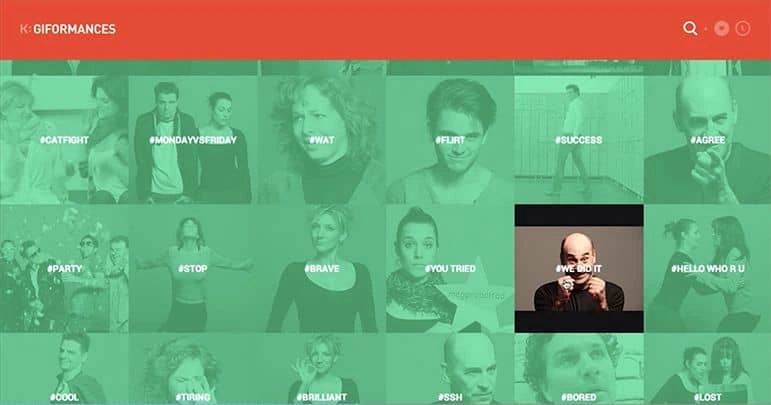
The response was impressive. Giformances got front-page news coverage on every major media outlet and was featured on primetime TV news. Plus, they’ve attracted over 200k unique users to date. Pretty good for a organization that felt it was unnoticed.
In this campaign, the Katona József Theatre demonstrated an awareness of cultural trends that would resonate with an audience they wanted to gain some traction with. In addition to considering a new social media platform for your campaign, you can also make waves by thinking of a unique way to present your content.
7. Showcase your use case: Living with Lag
People don’t like slow internet. So, it stands to reason that people will like a company who gives them fast internet. Ume.net, a fiber broadband provider, set out to prove their speediness in a unique way. They made a YouTube video of people trying to do everyday tasks with an Oculus Rift headset programmed with a three-second delay. The idea was to illustrate the woes of lagging internet in an offline setting. It was a light-hearted and creative campaign, and the YouTube video currently has almost 6 million views. Check it out:
Ume.net recognized that Oculus Rift headsets are en vogue right now, similar to the way the Katona József Theatre recognized the hipness of GIFs. Plus, ume.net invested in a great-looking video that did justice to their creative idea. It’s good to consider which campaigns can be done with little or no funding and which ones might require a little monetary love to take flight.
8. Time your efforts: Marie Callender’s
Ads are another option to consider when working with social media. Ads can leave a bad taste in our mouth, so when we see something that defies that expectation, it stands out. Marie Callender’s hit this nail on the head with tempting ads that spoke to the sudden craving for warm comfort food that might strike in cold weather. Here’s what they looked like:

The ads were wisely placed on Weather.com, targeting people who were checking the weather on a cold or rainy day. These aren’t social media ads, but the same principles of creativity and timing apply. Some great opportunities are holiday-themed posts or something that celebrates a milestone for your company (like this post). If you’re thoughtful with advertising and know the right moment to reach your customers, then you have a recipe for success.
9. Streamline the customer experience: Domino’s
When Domino’s was developing their social media strategy, they didn’t just fall back on the appeal of a delightful, melty slice of pizza. They took what is already inherently appealing about their brand and combined it with something that is quickly becoming almost as iconic as pizza: the emoji.
On Twitter, Domino’s fans can order a pizza by simply tweeting a pizza emoji. This is a unique and creative use of Twitter, and it’s particularly interesting because it is simultaneously a campaign and a transaction. That’s impressive efficiency. You can see from the photo below how many Twitter followers Domino’s has earned:
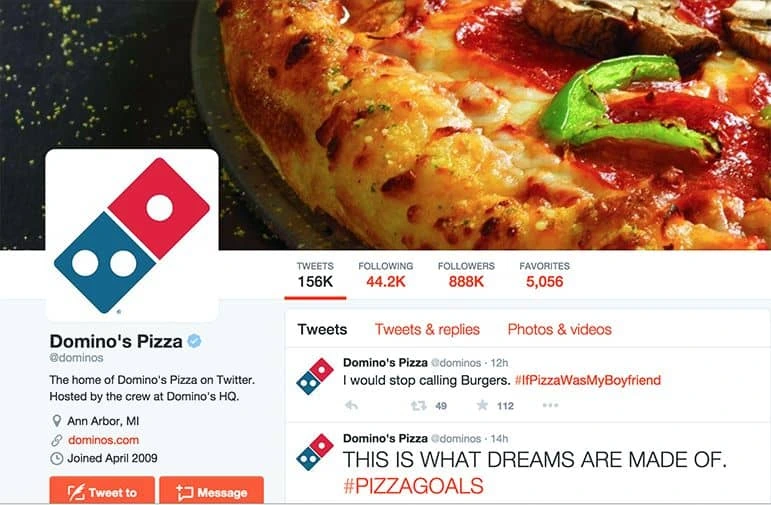
10. Match the campaign to the platform: #LastSelfie
Snapchat: the social media craze that has won the hearts of teens and millennials everywhere. Why not use it to inspire social activism? The World Wildlife Fund came up with a very clever way to utilize the Snapchat medium to rally support for endangered species. As is the case for all Snapchat photos, the ads that came up were only visible for a few seconds, then they were gone forever, hinting at the possibility of endangered animals disappearing for good if they go extinct.
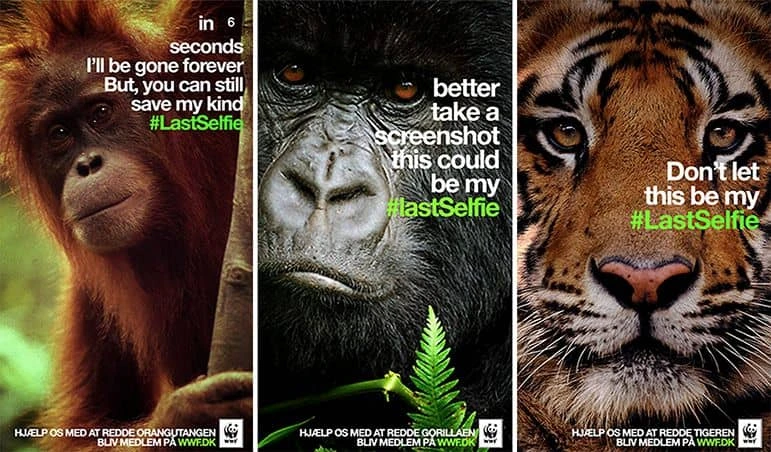
WWF reached their monthly donation goal in just 3 days thanks to this social media campaign. This is a great example of perfectly matching the campaign to the platform in order to really stand out. When you’re putting together your next campaign, consider taking time to note the core characteristics of a few different social media platforms. That way, you can tailor your ads to work in harmony with them.
The 10 best B2B social media campaigns you haven’t tried yet
By now, we’ve all heard how social media can support a brand and make it easier to connect with customers. But not all of us have the benefit of being a consumer-facing brand like Pepsi, Domino’s, or Oreo. If you’re representing a B2B brand, can you still take advantage of social media? Absolutely!
Here are 10 of our favorite examples of B2B brands using social media to build their brands and make an impact online
10. Build brand awareness: MailChimp on Instagram
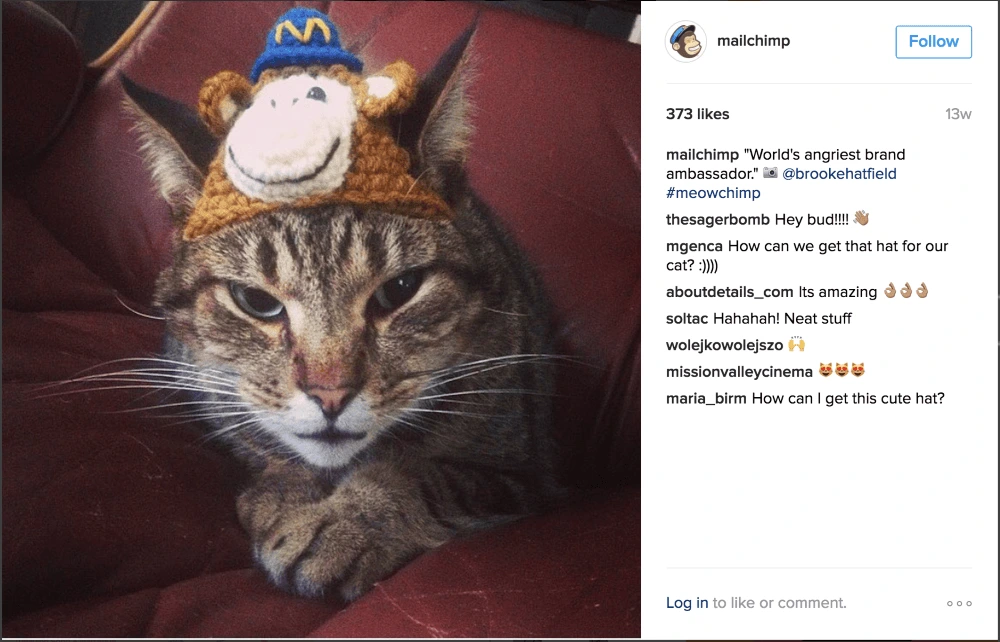
If you take a cursory glance at MailChimp’s Instagram account, one thing is immediately clear: That gosh-dang monkey is everywhere. (Forgive my crude Utah language.) But there’s a good reason for it. “Freddie” the monkey has been MailChimp’s loyal brand ambassador since the beginning, and while he’s gone through a few changes over the years, his fun personality still shines through.
As a visual platform, Instagram is specially suited to sharing Freddie’s shenanigans and encouraging MailChimp fans to do the same. From figurines to knitted caps, he is a constant reminder of the brand without being too ‘on the nose’, and he keeps MailChimp top-of-mind for its followers. (Bonus tip? On the internet, you can never go wrong with cats.)
9. Show off your expertise: Huawei on Twitter

Huawei is the largest manufacturer of telecommunications equipment in the world. Yet, if you asked the average American, it’s unlikely they’d know much about this giant company headquartered in China. That hasn’t stopped the brand from embracing social media in various countries and building up an appreciative audience for its content.
Huawei spotlights innovative technology trends and predictions for the future, inviting experts to weigh in on the tough questions (“Can AI ever function like a human?”) that make for rich conversations. Its Twitter timeline is chock-full of thought-provoking quotes from industry leaders.
By taking the time to create smart, dense content, Huawei sets itself apart from other social media accounts who find it easier to keep things fluffy.
8. Join relevant groups: Lucidpress on LinkedIn
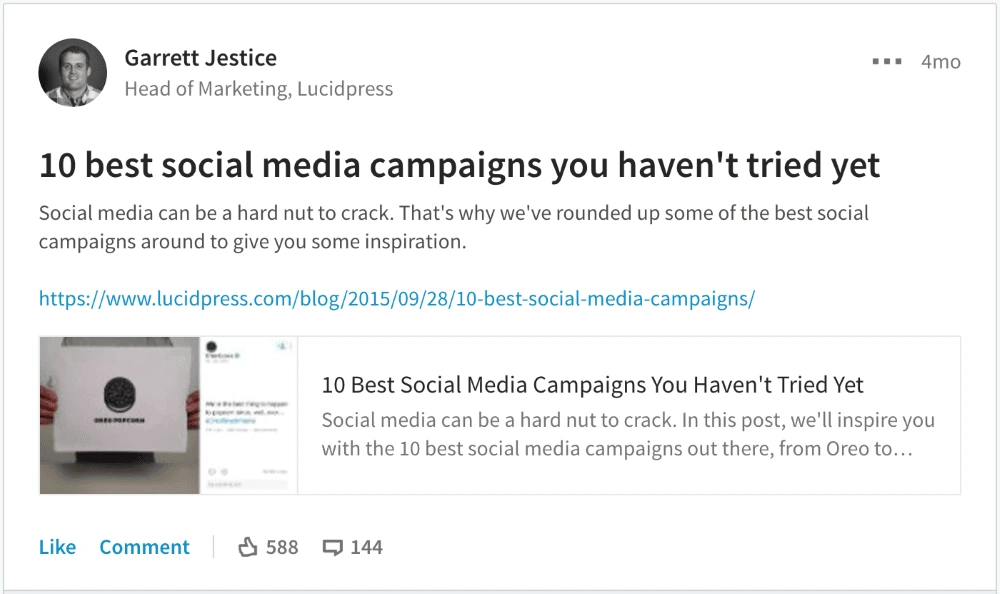
If we want to talk the talk, we’d better walk the walk.
Although Lucidpress isn’t strictly a B2B brand, we serve a large number of businesses who use Lucid’s software across various departments. To reach these businesses, we have found that it’s better to go where your audience is than to expect it to come to you. One way to do that is to join relevant LinkedIn groups and share your content with them. It’s this strategy that likely brought many of you here today, as a follow-up to one of our most successful LinkedIn conversations.
Due to the many comments and feedback in that conversation, we realized there was a content need we were not filling (that is, looking at social media from a B2B perspective), and it gave us the opportunity to serve our B2B users better.
7. Share your human side: Novartis on Facebook
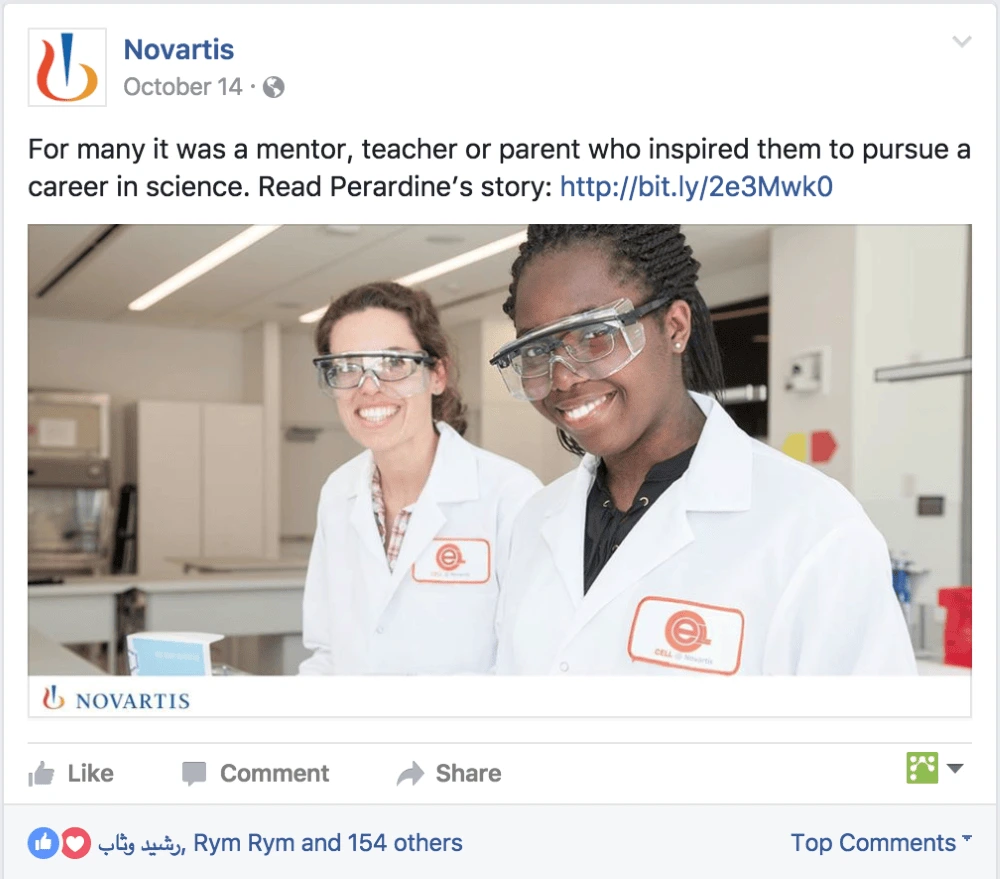
As a B2B brand, it can be difficult to express humanity online. What I mean by that is a corporation can start to feel like a faceless monolith (“We appreciate your business”) when compared to real, one-on-one connections with other people (“I’m so glad you called!”).
Novartis, the multinational pharmaceutical company, has found a wonderful way to remind us that organizations are made up of real people with unique stories and goals, by spotlighting individuals who work or intern there on its Facebook page.
The best part about this strategy is that any brand can use it, because every brand has fascinating people working behind the scenes. Take a look around your office and see who’s got a story to tell. We guarantee your users will relate and respond far better to that than to your next press release.
6. Create a community: American Express on Twitter
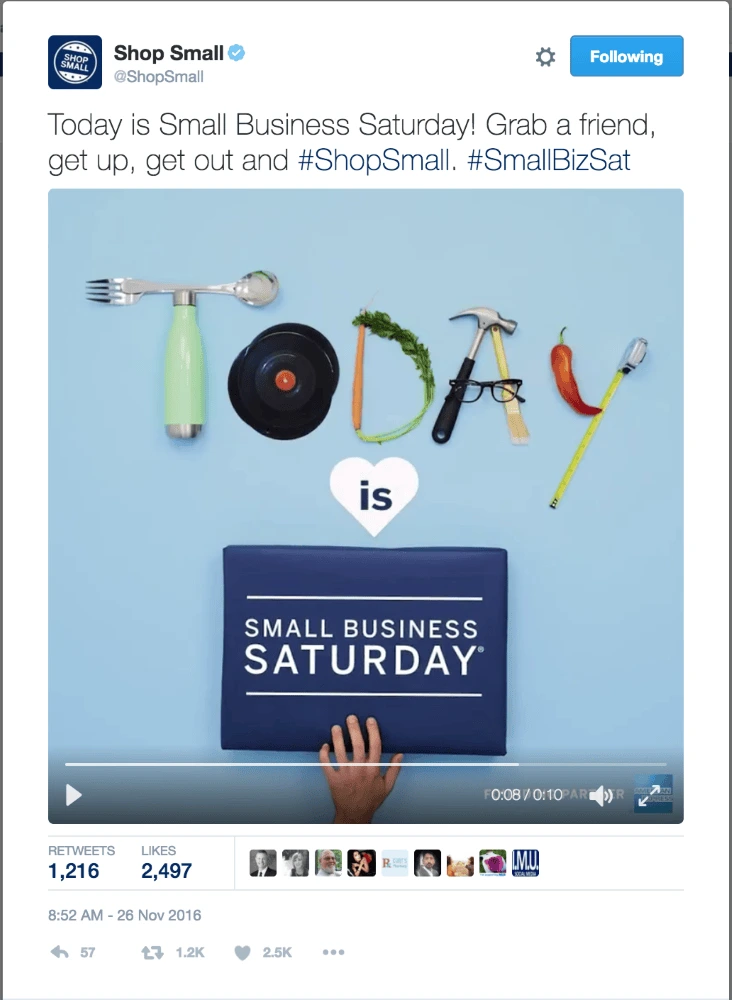
American Express has been recognized in the past for OPEN Forum, its small-business blog—and rightly so. But its dedication to serving SMBs crossed over into social media with the creation of the @ShopSmall Twitter account. @ShopSmall is active throughout the year, but things really ramp up in the fall in preparation for November’s #SmallBizSat.
If you haven’t heard, Small Business Saturday is a national holiday (first sponsored by American Express in 2010) that takes place between Black Friday and Cyber Monday. It encourages shoppers to support small and local businesses—just the kind of places American Express hopes to service.
@ShopSmall is a hyper-focused social media account that leverages the larger SMB community American Express has built over the years, and the community’s passion and enthusiasm are contagious.
5. Highlight user-created content: Maersk on Instagram

What do you get when you combine smartphone photography, shipping containers, and the open sea? For Maersk, the world’s largest container ship and supply vessel operator, you get one hell of an Instagram account. Thanks to pilots, sailors, and travel professionals around the world, Maersk has a deep well of user-generated photos to share with its 77.4k followers.
And the pictures are good. Like, really good. If you had told me that one of the best business Instagram accounts out there specialized in photos of shipping containers, I’m not sure you could’ve convinced me. But after scrolling past sun-lit ocean horizons, grand heavy ships that miraculously still float, and even the occasional double rainbow… I’m a believer.
(And, like Maersk, if you decide to use this tactic for your social media, don’t forget to credit the awesome folks who create branded content for you.)
4. Feature your customers: Square on Facebook
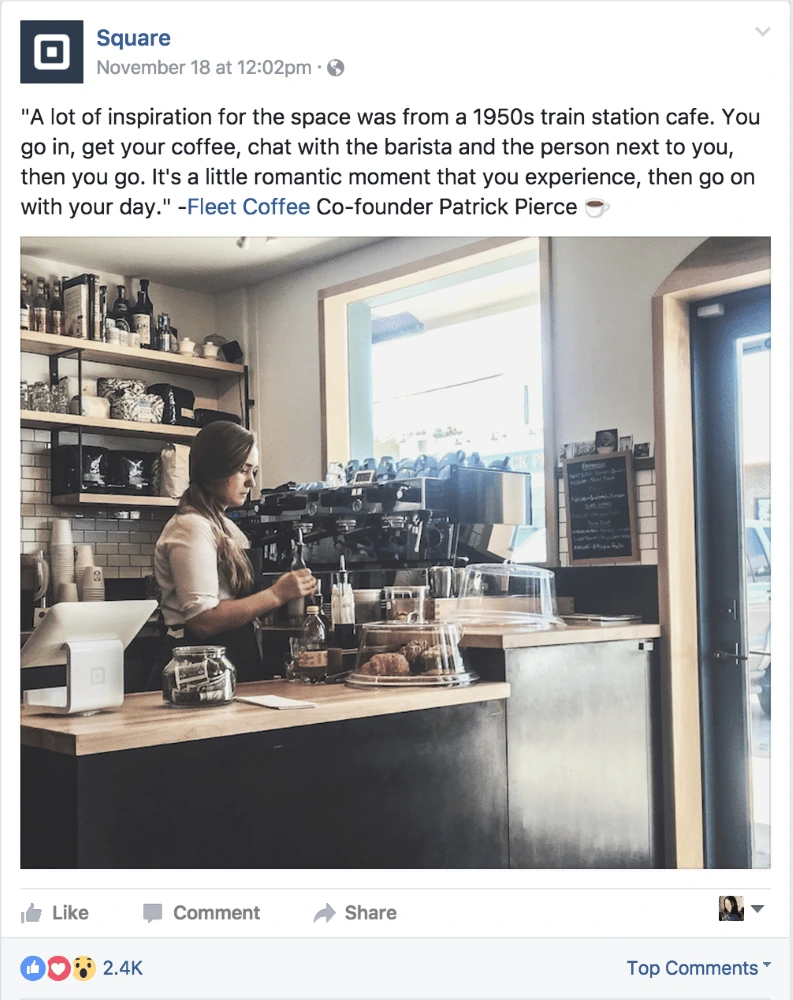
Like we learned from the Novartis example, stories about real people are compelling. But rather than turning its focus within, Square looks out towards its customers for social media inspiration.
Its Facebook page features slice-of-life photos of small businesses and the people who own them, people who depend on Square for payment processing. Next to the photo is a quote handpicked from a longer interview, where you get a glimpse into the daily lives of SMB owners around the country.
In this example, Fleet Coffee in Austin, Texas, is tagged so readers can easily visit their page. It’s not hard to imagine that this feature brought Fleet Coffee a few new followers—which is a nice way for Square to give a little bit back to the folks who keep them in business.
3. Display your culture: Intuit on LinkedIn
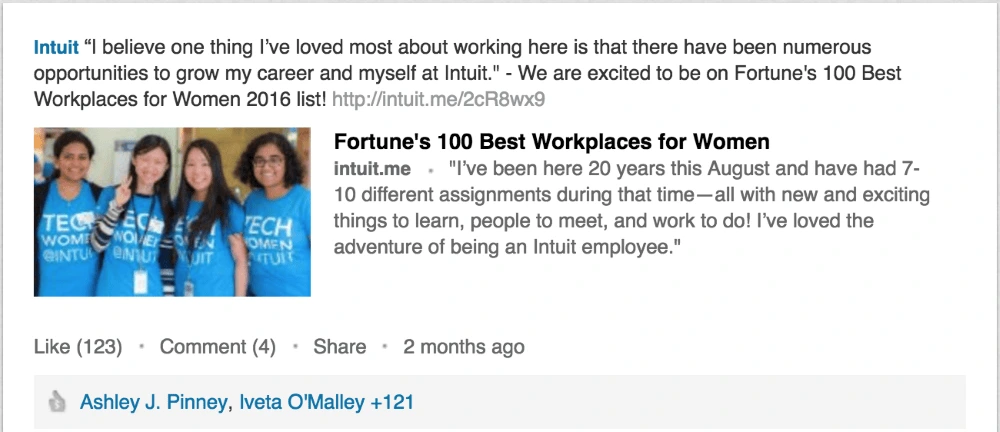
Got a company culture that you’re proud of? Share it! LinkedIn is the network of choice for business professionals, which means it’s the perfect place to share updates about awards, activities, and other exciting announcements pertaining to your company. As you can see in this update, the award shows that Intuit values a diverse culture that offers opportunities to women in tech.
Sharing what makes your company a great place to work offers dual benefits. First, it assures potential B2B clients and partners that you care about your people and will likely work hard to treat them fairly. Second, it attracts top talent who shares your values, which makes it easier to keep your culture strong. So don’t be shy—when it comes to culture, it’s okay to brag a little bit.
2. Give a peek behind the curtain: Sunnybrook Hospital on Twitter
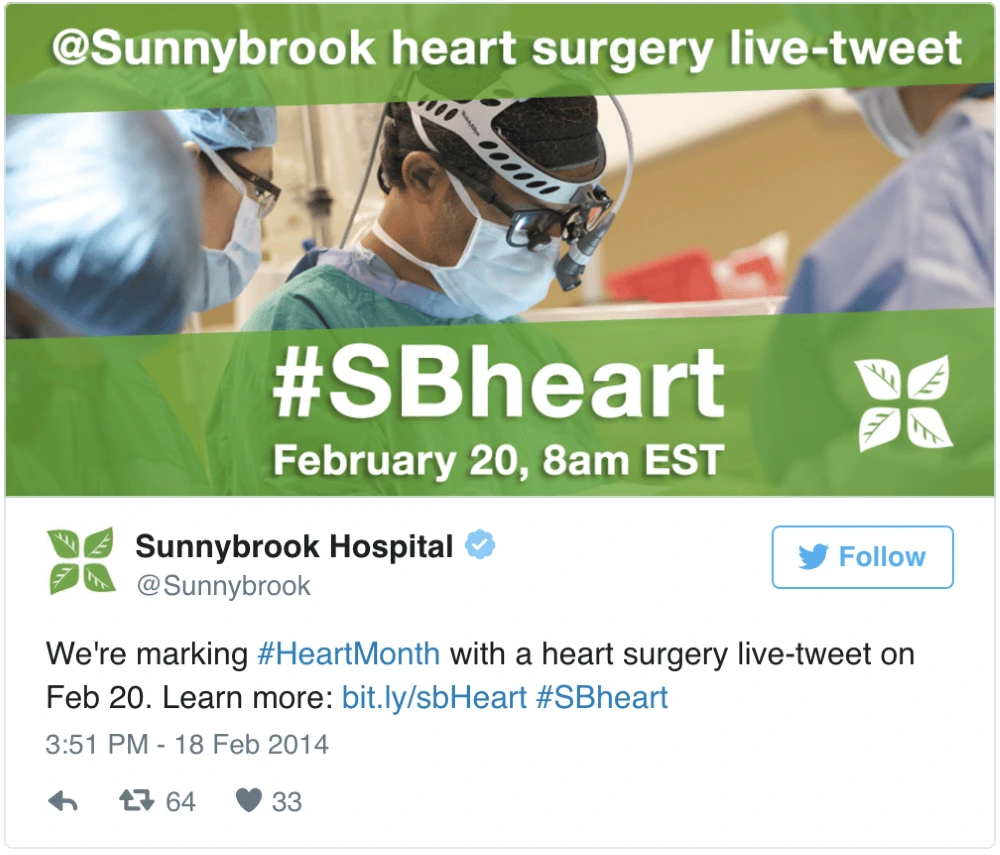
As you go about your daily work, consider that what might seem like regular routine to you could be fascinating and new for your audience. For example, take a look at the healthcare industry. Sunnybrook Hospital in Toronto, Ontario, came up with a fascinating way to give its followers a peak behind the curtain—by livetweeting a patient’s heart surgery.
As part of its efforts to raise awareness for Heart Month in February, the hospital livetweeted a coronary artery bypass graft over the course of nearly eight hours (with consent from the patient, of course). This unique use of social media attracted media coverage for their cause, which means the surgery and the strategy were both a great success.
To see the tweets, check out this Storify link (be advised: some tweets contain graphic medical content). Are there processes or procedures going on “behind the scenes” that you could share with your followers?
1. Don’t be afraid to try something new: General Electric on Instagram (Stories)
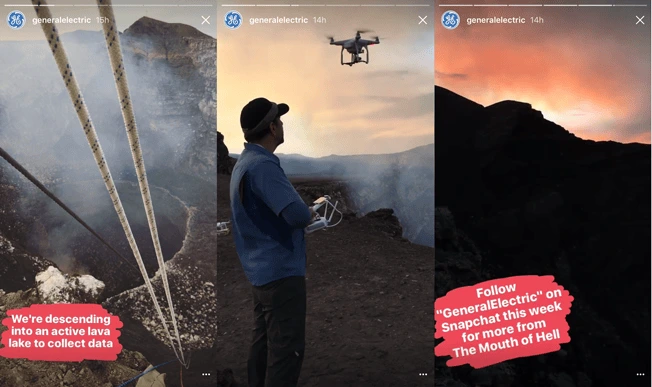
It’s almost impossible to talk about B2B social media without mentioning General Electric. The digital/industrial giant maintains a presence on all the major social networks and has earned praise for campaigns in the past like #ILookLikeAnEngineer, which highlighted women and minorities working in a white-male-dominated field. But what earns GE a spot on this list is not what they do on Facebook or Twitter.
It’s the willingness to experiment with new forms of social media, trying out innovative content and new platforms that might scare other brands away. GE was on Vine the day after it launched, it’s on Snapchat, and when Instagram launched Stories in August, GE was there with an exploration of the Masaya Volcano in Nicaragua.
While it might not keep or update every platform, GE strikes while the iron is hot and earns valuable views in the process.
It turns out that, with a little ingenuity, B2B brands can make just as big a splash on social media as any other brand. Next time you’re planning a social media campaign, try out some of these ideas.
How can you compete with the best social media campaigns? First of all, you need to know your customers well. To interact with them in a friendly way, you need to understand their desires and interests. Then it’s time to brainstorm and put your best social media campaign ideas into action. With hard work, you can run a clever, successful social media campaign that takes your brand to the next step, whether that’s getting it on the map or earning a million more customers.
Eager to adapt your brand to social media channels? Grab a copy of our free eBook: How to adapt your brand to social media
By now, we’ve all heard how social media can support a brand and make it easier to connect with customers. But not all of us have the benefit of being a consumer-facing brand like Pepsi, Domino’s, or Oreo. If you’re representing a B2B brand, can you still take advantage of social media? Absolutely!
Is your brand new to social media? Grab a copy of our free eBook: How to adapt your brand to social media
As a follow-up to one of our most popular posts, here are 10 of our favorite examples of B2B brands using social media to build their brands and make an impact online.
10. Build brand awareness: MailChimp on Instagram
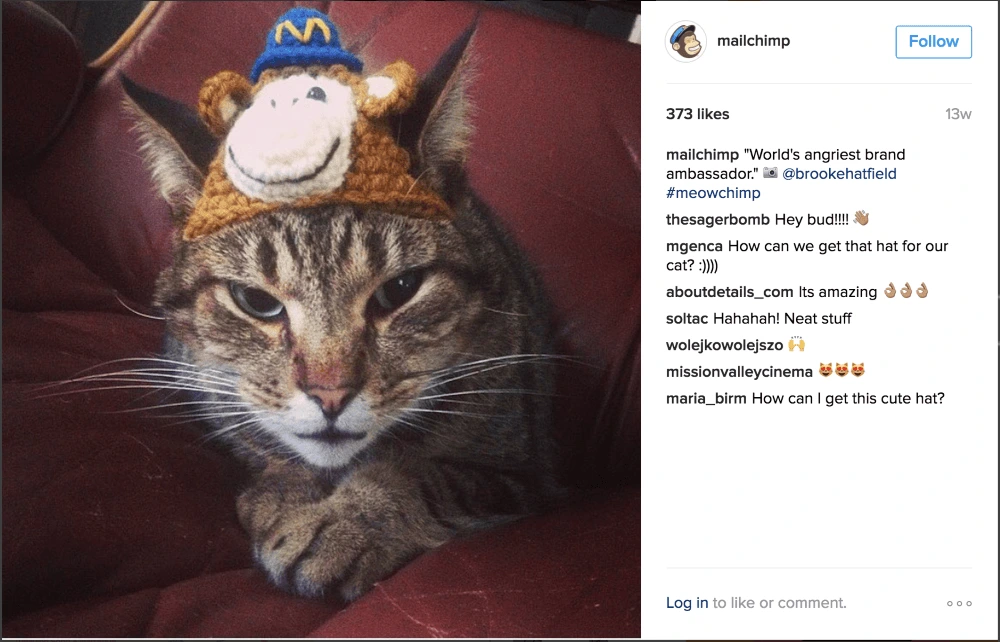
If you take a cursory glance at MailChimp’s Instagram account, one thing is immediately clear: That gosh-dang monkey is everywhere. (Forgive my crude Utah language.) But there’s a good reason for it. “Freddie” the monkey has been MailChimp’s loyal brand ambassador since the beginning, and while he’s gone through a few changes over the years, his fun personality still shines through.
As a visual platform, Instagram is specially suited to sharing Freddie’s shenanigans and encouraging MailChimp fans to do the same. From figurines to knitted caps, he is a constant reminder of the brand without being too ‘on the nose’, and he keeps MailChimp top-of-mind for its followers. (Bonus tip? On the internet, you can never go wrong with cats.)
9. Show off your expertise: Huawei on Twitter

Huawei is the largest manufacturer of telecommunications equipment in the world. Yet, if you asked the average American, it’s unlikely they’d know much about this giant company headquartered in China. That hasn’t stopped the brand from embracing social media in various countries and building up an appreciative audience for its content.
Huawei spotlights innovative technology trends and predictions for the future, inviting experts to weigh in on the tough questions (“Can AI ever function like a human?”) that make for rich conversations. Its Twitter timeline is chock-full of thought-provoking quotes from industry leaders.
By taking the time to create smart, dense content, Huawei sets itself apart from other social media accounts who find it easier to keep things fluffy.
8. Join relevant groups: Lucidpress on LinkedIn
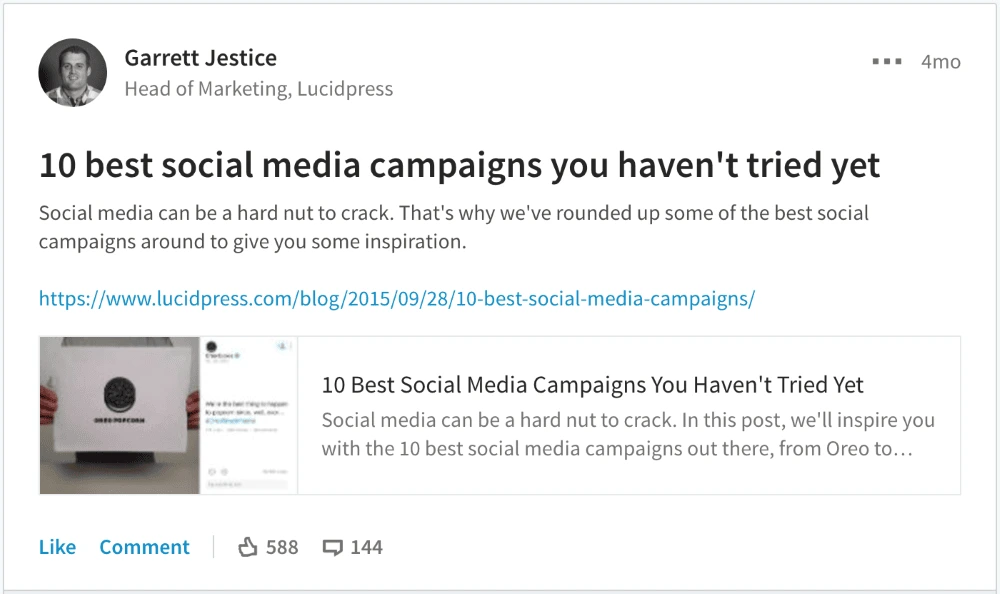
If we want to talk the talk, we’d better walk the walk.
Although Lucidpress isn’t strictly a B2B brand, we serve a large number of businesses who use Lucid’s software across various departments. To reach these businesses, we have found that it’s better to go where your audience is than to expect it to come to you. One way to do that is to join relevant LinkedIn groups and share your content with them. It’s this strategy that likely brought many of you here today, as a follow-up to one of our most successful LinkedIn conversations.
Due to the many comments and feedback in that conversation, we realized there was a content need we were not filling (that is, looking at social media from a B2B perspective), and it gave us the opportunity to serve our B2B users better.
7. Share your human side: Novartis on Facebook
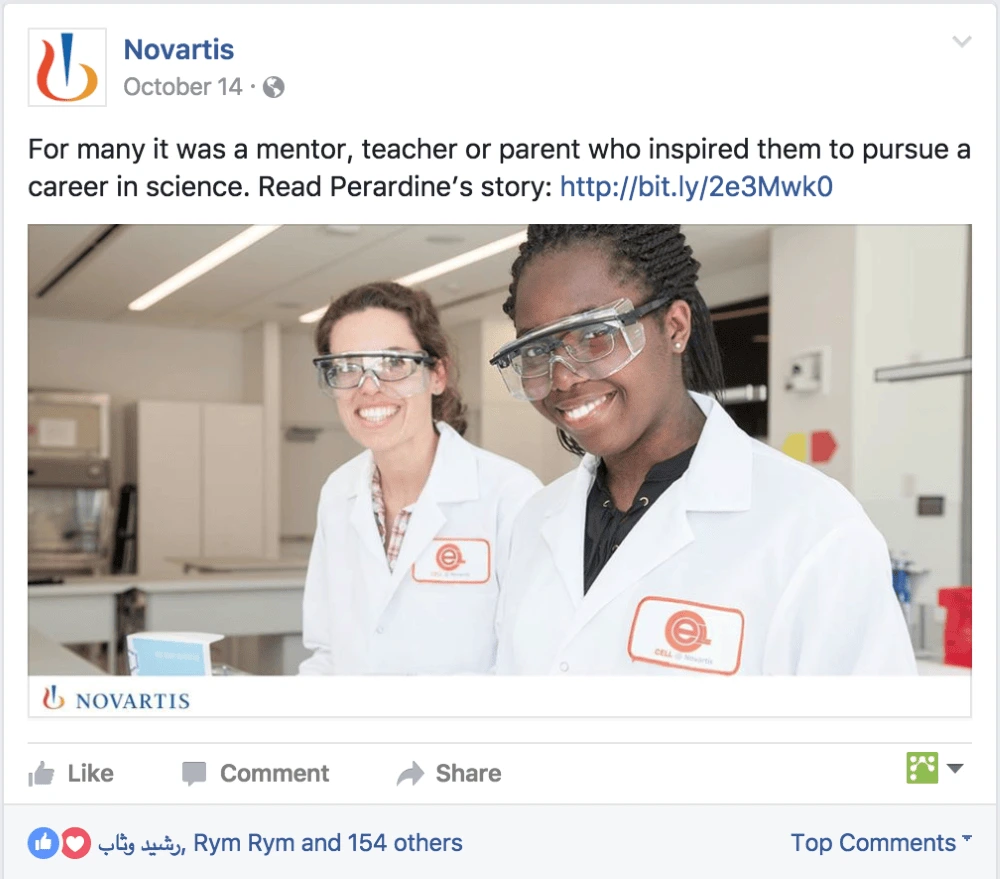
As a B2B brand, it can be difficult to express humanity online. What I mean by that is a corporation can start to feel like a faceless monolith (“We appreciate your business”) when compared to real, one-on-one connections with other people (“I’m so glad you called!”).
Novartis, the multinational pharmaceutical company, has found a wonderful way to remind us that organizations are made up of real people with unique stories and goals, by spotlighting individuals who work or intern there on its Facebook page.
The best part about this strategy is that any brand can use it, because every brand has fascinating people working behind the scenes. Take a look around your office and see who’s got a story to tell. We guarantee your users will relate and respond far better to that than to your next press release.
6. Create a community: American Express on Twitter
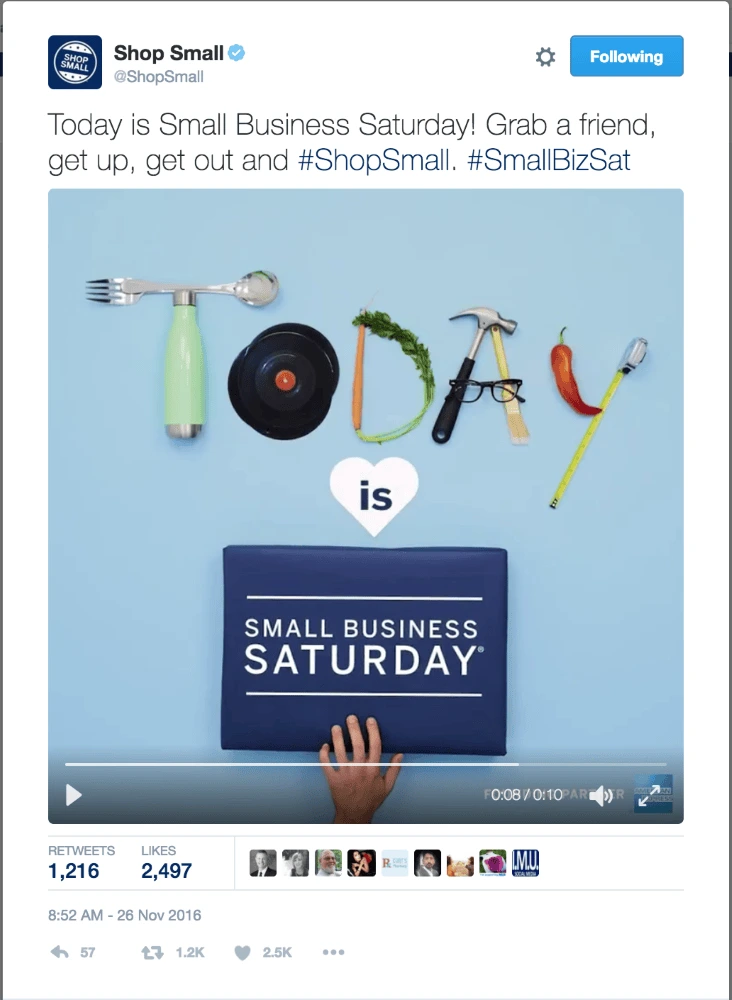
American Express has been recognized in the past for OPEN Forum, its small-business blog—and rightly so. But its dedication to serving SMBs crossed over into social media with the creation of the @ShopSmall Twitter account. @ShopSmall is active throughout the year, but things really ramp up in the fall in preparation for November’s #SmallBizSat.
If you haven’t heard, Small Business Saturday is a national holiday (first sponsored by American Express in 2010) that takes place between Black Friday and Cyber Monday. It encourages shoppers to support small and local businesses—just the kind of places American Express hopes to service.
@ShopSmall is a hyper-focused social media account that leverages the larger SMB community American Express has built over the years, and the community’s passion and enthusiasm are contagious.
5. Highlight user-created content: Maersk on Instagram

What do you get when you combine smartphone photography, shipping containers, and the open sea? For Maersk, the world’s largest container ship and supply vessel operator, you get one hell of an Instagram account. Thanks to pilots, sailors, and travel professionals around the world, Maersk has a deep well of user-generated photos to share with its 77.4k followers.
And the pictures are good. Like, really good. If you had told me that one of the best business Instagram accounts out there specialized in photos of shipping containers, I’m not sure you could’ve convinced me. But after scrolling past sun-lit ocean horizons, grand heavy ships that miraculously still float, and even the occasional double rainbow… I’m a believer.
(And, like Maersk, if you decide to use this tactic for your social media, don’t forget to credit the awesome folks who create branded content for you.)
4. Feature your customers: Square on Facebook
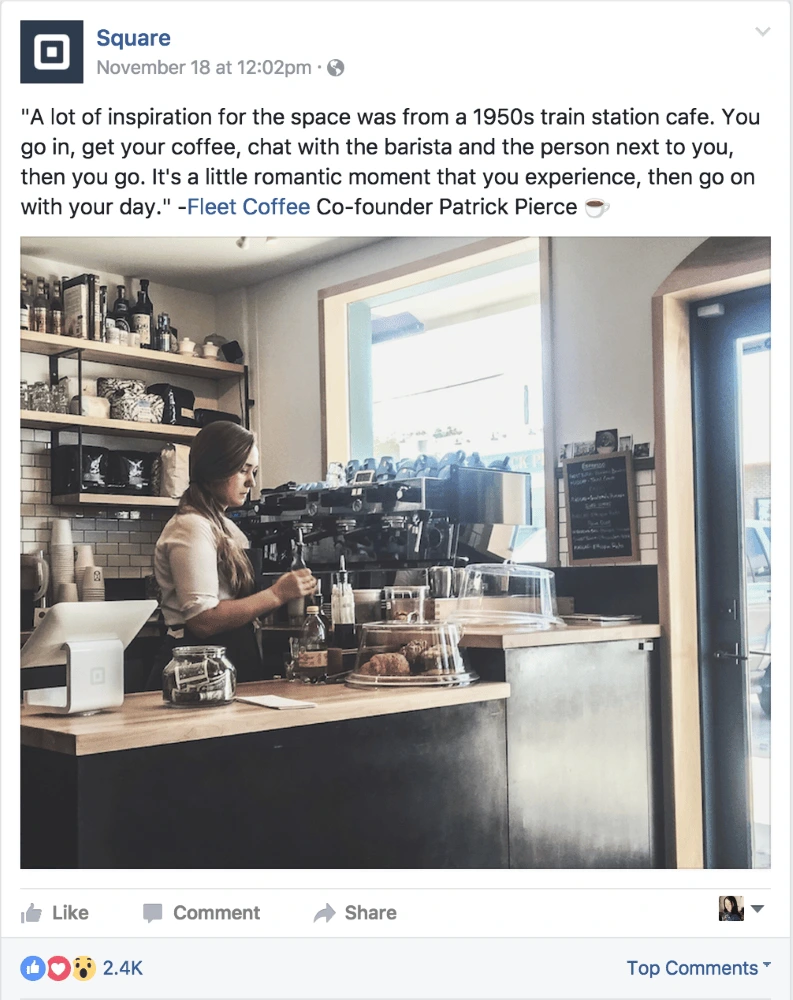
Like we learned from the Novartis example, stories about real people are compelling. But rather than turning its focus within, Square looks out towards its customers for social media inspiration.
Its Facebook page features slice-of-life photos of small businesses and the people who own them, people who depend on Square for payment processing. Next to the photo is a quote handpicked from a longer interview, where you get a glimpse into the daily lives of SMB owners around the country.
In this example, Fleet Coffee in Austin, Texas, is tagged so readers can easily visit their page. It’s not hard to imagine that this feature brought Fleet Coffee a few new followers—which is a nice way for Square to give a little bit back to the folks who keep them in business.
3. Display your culture: Intuit on LinkedIn
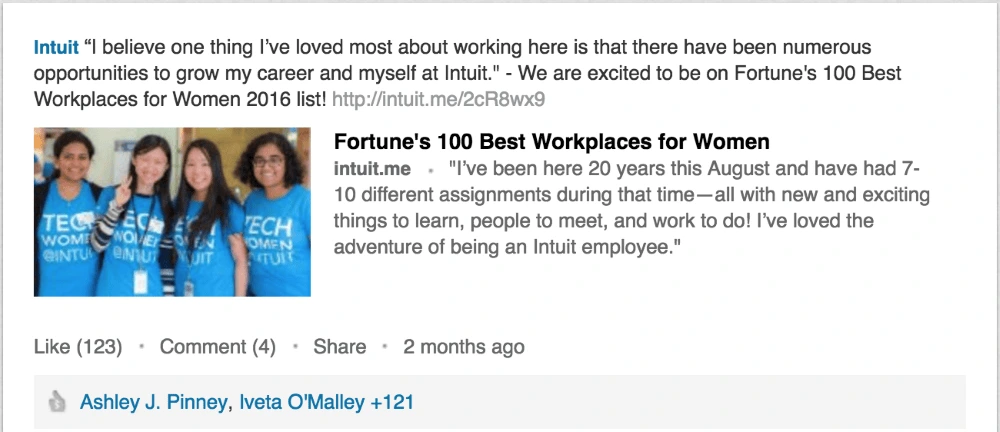
Got a company culture that you’re proud of? Share it! LinkedIn is the network of choice for business professionals, which means it’s the perfect place to share updates about awards, activities, and other exciting announcements pertaining to your company. As you can see in this update, the award shows that Intuit values a diverse culture that offers opportunities to women in tech.
Sharing what makes your company a great place to work offers dual benefits. First, it assures potential B2B clients and partners that you care about your people and will likely work hard to treat them fairly. Second, it attracts top talent who shares your values, which makes it easier to keep your culture strong. So don’t be shy—when it comes to culture, it’s okay to brag a little bit.
2. Give a peak behind the curtain: Sunnybrook Hospital on Twitter
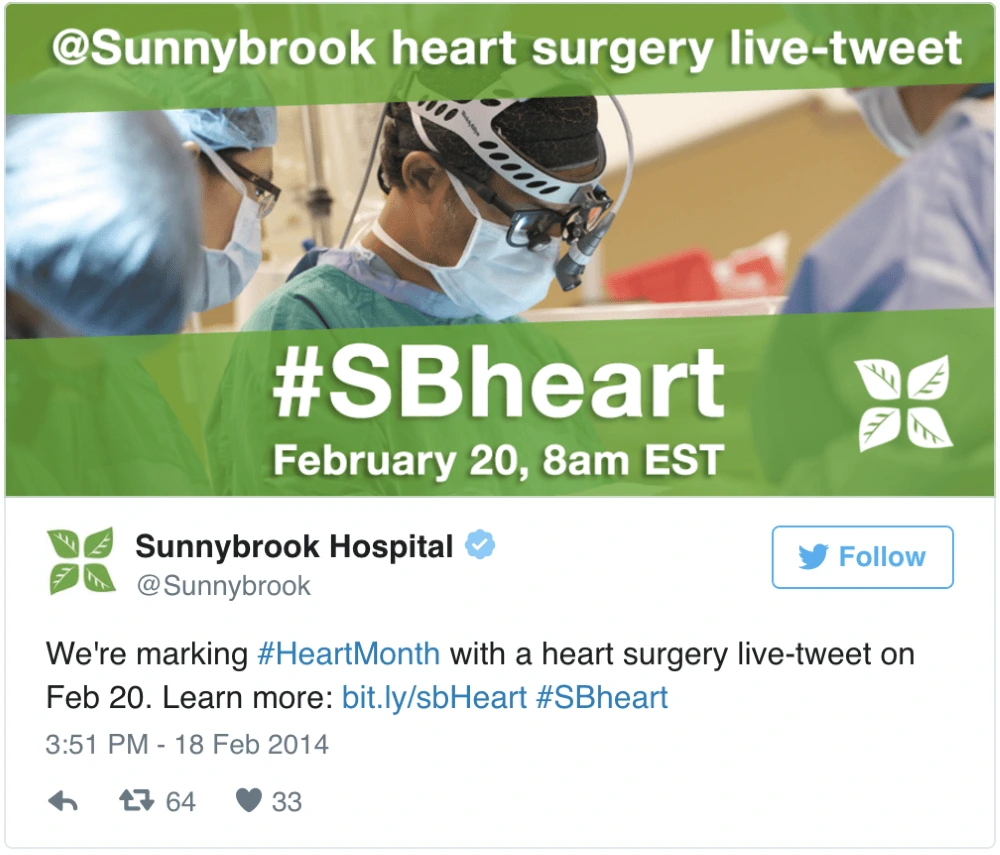
As you go about your daily work, consider that what might seem like regular routine to you could be fascinating and new for your audience. For example, take a look at the healthcare industry. Sunnybrook Hospital in Toronto, Ontario, came up with a fascinating way to give its followers a peak behind the curtain—by livetweeting a patient’s heart surgery.
As part of its efforts to raise awareness for Heart Month in February, the hospital livetweeted a coronary artery bypass graft over the course of nearly eight hours (with consent from the patient, of course). This unique use of social media attracted media coverage for their cause, which means the surgery and the strategy were both a great success.
To see the tweets, check out this Storify link (be advised: some tweets contain graphic medical content). Are there processes or procedures going on “behind the scenes” that you could share with your followers?
1. Don’t be afraid to try something new: General Electric on Instagram (Stories)
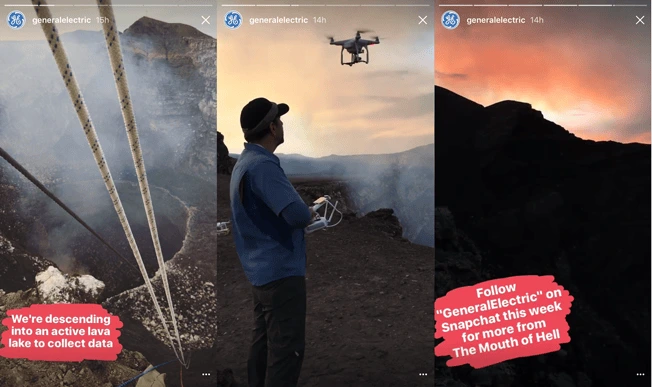
It’s almost impossible to talk about B2B social media without mentioning General Electric. The digital/industrial giant maintains a presence on all the major social networks and has earned praise for campaigns in the past like #ILookLikeAnEngineer, which highlighted women and minorities working in a white-male-dominated field. But what earns GE a spot on this list is not what they do on Facebook or Twitter.
It’s the willingness to experiment with new forms of social media, trying out innovative content and new platforms that might scare other brands away. GE was on Vine the day after it launched, it’s on Snapchat, and when Instagram launched Stories in August, GE was there with an exploration of the Masaya Volcano in Nicaragua.
While it might not keep or update every platform, GE strikes while the iron is hot and earns valuable views in the process.
It turns out that, with a little ingenuity, B2B brands can make just as big a splash on social media as any other brand. Next time you’re planning a social media campaign, try out some of these ideas. Did we miss any of your favorites? Share them in the comments below!
Is your brand new to social media? Grab a copy of our free eBook: How to adapt your brand to social media
Engaging followers on social media to boost your brand’s popularity is a fine art. Undoubtedly, your audience is spending a sizable chunk of their time on social, but there are way too many things competing for their attention there.
Related: 10 best social media campaigns you haven’t tried yet
If you don’t want to simply get scrolled past in the news feed, you need a better social media strategy. And to build one, you need to experiment with different techniques. Today, we’re going to take notes from the pros. Here are 5 social media hacks to get the right people to notice your brand, engage with your content, and share your posts.
1. Starbucks—Involve your audience in your campaign
A picture is worth a thousand words, right? Well, what if you could share your product’s best pictures on Instagram… by getting your followers to do it for you? That’s exactly what Starbucks has done with a host of seasonal hashtags.
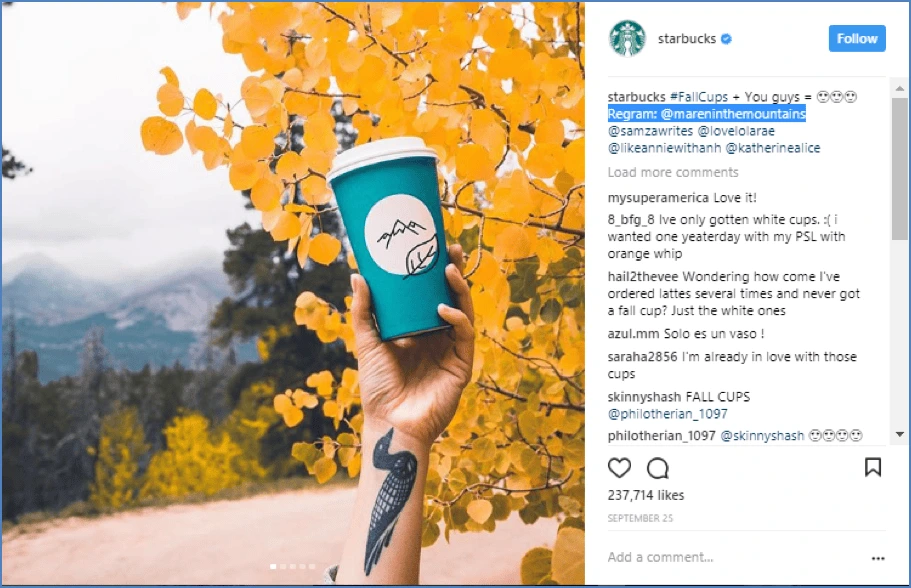
Source: Instagram
Starbucks constantly encourages followers to share their photos and, over time, has built a very active community of coffee lovers. They post their photos, and Starbucks shares the ones they like best.
As a result, the photo-taker gets attention and accolades, reinforcing the positive affinity they have for the brand. And Starbucks gets to spread beautiful pictures of their product that drive more engagement with their content.
You too can explore this option, starting by building a small community of users who love your product. Invite them to share pictures of themselves using your product, and watch how a win-win game can score points both for you and for your audience.
2. Just Eat—Hashtag your giveaways
Giving away freebies isn’t exactly a groundbreaker in business strategy, but there’s a better way to gain maximum impact. The food delivery app Just Eat nails this practice. It’s constantly running themed contests and food giveaways that ask users to tag their friends, send in entries, and generally join in the fun. As a result, for every item given away, Just Eat earns a great deal of traction and puts people in just the right mood for ordering food. #FindYourFlavor, #JustEatUK and #StrangerThings2 are just a few examples.
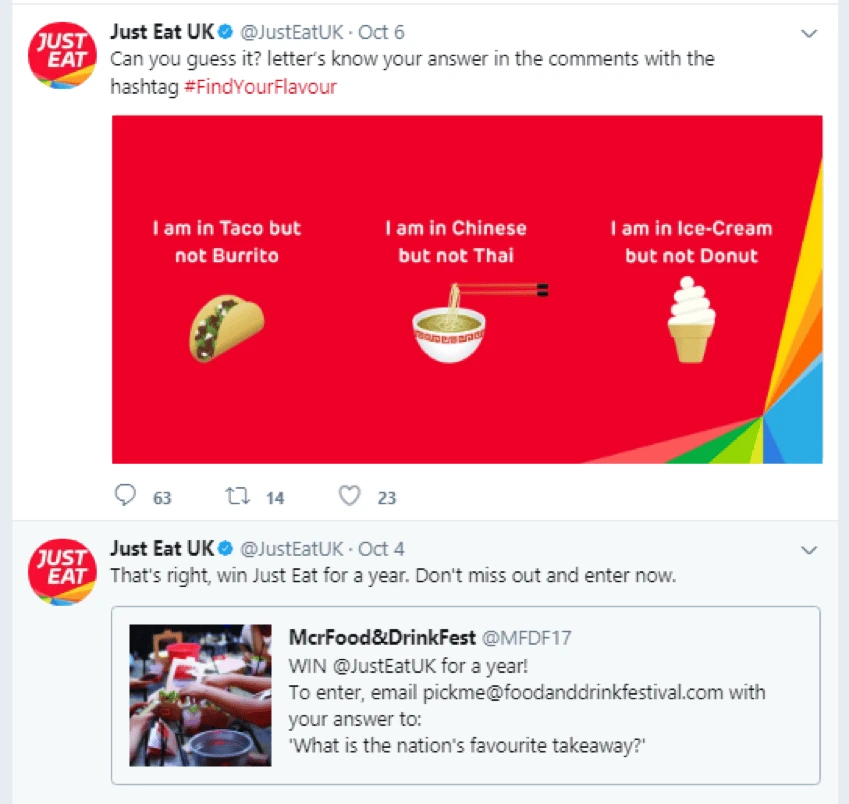
Source: Twitter
3. Lyft—Start a conversation
“While rival Uber is an efficient delivery service, Lyft is seeking to differentiate itself by offering a combination of ‘humanity and technology.”
Kira Wampler, Lyft CMO
Lyft crafts its social media strategy in that same vein by posting customer reviews, messages and conversations on their Twitter page. It aims to establish an identity as a warm, friendly taxi experience that nurtures relationships and cares about every single passenger. In fact, fantastic customer service has been Lyft’s calling card from the start, so playing it up on social media is a smart, brand-consistent move.
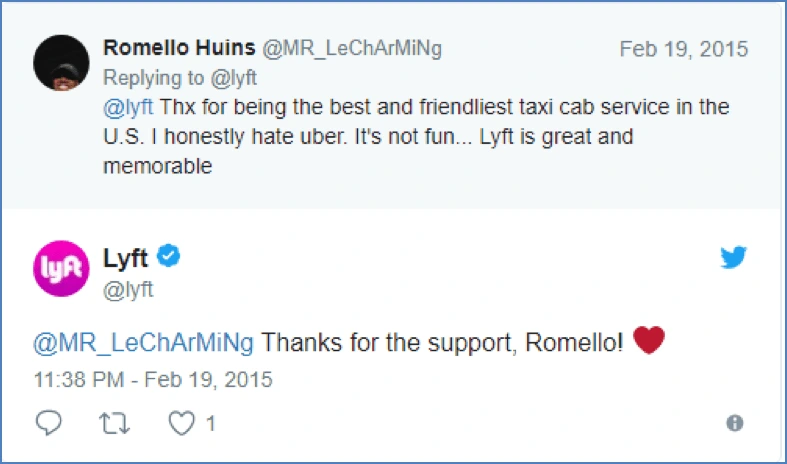
Source: Twitter
We all want to do business with brands that make us feel special. [![]() ] Forming personal relationships through conversation is basic human nature. You too can try exhibiting your warm, personal side by sharing users’ comments and conversations on your profile.
] Forming personal relationships through conversation is basic human nature. You too can try exhibiting your warm, personal side by sharing users’ comments and conversations on your profile.
4. Pokémon Go—Roll out teasers before major updates
Pokémon Go brought augmented reality gaming to the masses and attracted a huge fanbase in very little time. However, with shrinking attention spans, the initial excitement could’ve fizzled out quickly if they didn’t find ways to keep the buzz going.
Fans of Pokémon Go are treated to small doses of upcoming excitement through a regular cadence of trailers and teasers. The anticipation for new levels, more items, and higher scores is enough to make fans look forward to playing every update, making it one of the highest grossing games ever.
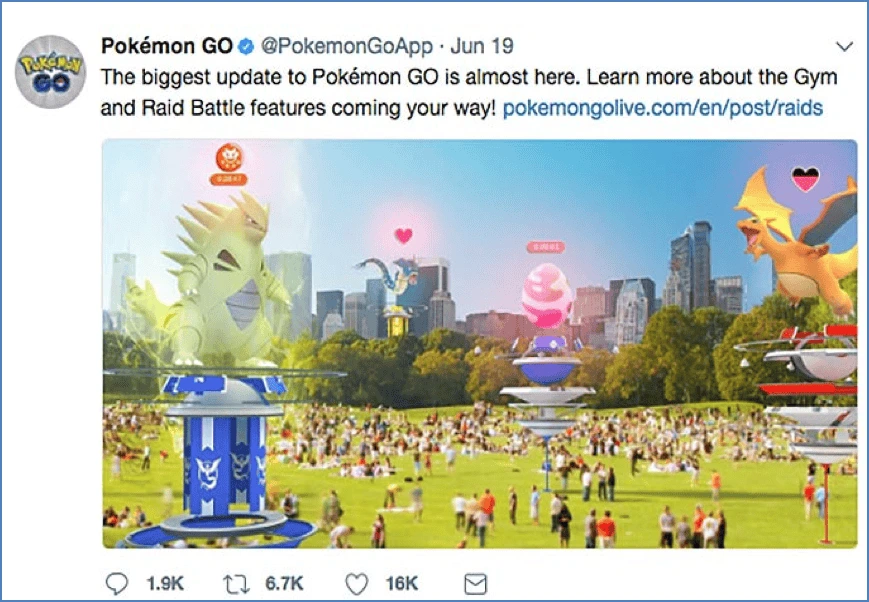
Source: Facebook
If you have a major update coming out, tease your followers with alluring clues, images and videos. This will keep the excitement alive until the update is finally out.
5. Angry Birds—Have a little fun with games
Angry Birds has been on social media since 2009, and from the start, their team has infused their brand’s personality with the fun of gaming. They are constantly running fun contests, posting fan artwork, giving away extra lives, and adding a light touch of humor to everything they post.
Plus, it’s not just your typical “share to win” giveaways. Contests come with clues and incentives to lure people into downloading the app. Riddles, puzzles, cryptic images and poems, it’s all there to keep users tuned in. Sometimes all it takes is a little fun and games to keep your audience engaged.
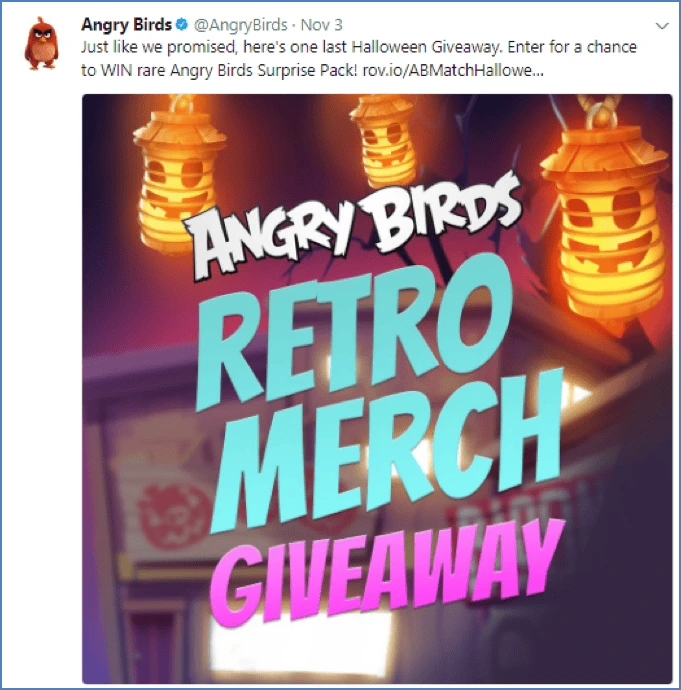
Source: Twitter
Wrapping up
Now you have 5 tried-and-tested strategies straight from the pros. These techniques can be adjusted and applied to nearly any brand willing to experiment with creative flair. The idea is to build connections and foster relationships with your users so you become part of their social lives. Try one (or more!) of the above tips and see how your audience responds—you might be surprised at your success.
Ready to drive more engagement and leads with social media? Grab a copy of our free eBook: How to adapt your brand to social media
Social media has changed a lot over the last decade—and the way marketers manage social media channels has changed, too. Few marketers have the bandwidth to stay on social media all day, curating and sharing content as they go. Many of us have additional job responsibilities, and we have to be structured and deliberate about the time we dedicate to social.
Related: 6 effective social media strategies to increase brand awareness
Fortunately for us, there are lots of tools out there designed to make social media management easier and more efficient. From finding sharable content to scheduling posts, the 30 tools listed below can help you streamline and automate the tasks you can—so you have more time to spend on the ones you can’t.
What is social media automation?
Before jumping into the list and trying out the tools, let’s quickly clarify what we mean by automation. Social media automation is using software or tools to accomplish specific tasks on social media platforms without human intervention. Put simply, it means using a program to automate things like posting and sharing content on Facebook, Twitter, and other platforms.
30 best social media automation tools
Without further ado, let’s get to our list. You’ll find big players and small players here, with a variety of specialties and capabilities, so there’s something for everyone. The descriptions are short, just to give you a general idea of each tool’s primary strengths. If you want more info, give one a click and check out their website.
Our picks for the 30 best social media automation tools out there today are…
1. Buffer
One of the market leaders, this popular tool lets you schedule & publish upcoming posts across all of your social media accounts. It also offers excellent analytics on your campaigns.
2. Hootsuite
Hootsuite is another popular choice. You can use it to schedule your posts and monitor the competition. Using search streams, you can more easily build a community of followers.
3. Workflow
With Workflow, you can craft the ideal workflows (hence the name) so that the right content is always shared at the right time.
4. SocialPilot
The tool automates the process of scheduling content across various social media accounts. You can also learn more about your followers, so you can determine the right content to post.
5. IFTTT
An acronym that stands for “If this, then that,” this free tool lets you set up rules for how different tools, apps and social media platforms trigger one another. It’s a simple concept that’s hard to explain, so pop over to their website for details and examples.
6. Sendible
The tool is designed to help you schedule updates, reply to followers, create reports, and collaborate with others.
7. Later
Later is a powerful tool for Instagram scheduling that boasts over 600k customers. Unlike many social media tools, you can use this one to manage comments.
8. Tailwind
Tailwind is an automated scheduling and analytics tool that’s great for Pinterest. It will recommend the best times for you to post to reach your audience.
9. CoSchedule
This application helps you to schedule all your posts. In fact, you can schedule over 60 posts at once! You can also use it to lay out your social media calendar.
10. Post Planner
This simple tool helps you to find content and schedule posts for your social media accounts.
11. Iconosquare
Iconosquare arms you with personalized information about your social media accounts that will help you manage activities more efficiently.
12. Agorapulse
You can easily plan and schedule posts across your social networks with this tool, but it’s also useful for tracking performance.
13. Crowdfire
This automation tool helps you root out inactive Twitter followers. It’s also worth using if you want to discover the right cadence and content to share with your audience.
14. Socialert
Social media listening is made much easier when you use this tool. Again, it’s all about finding the best content for your audience and being part of conversations as they happen.
15. BuzzSumo
BuzzSumo is popular with content marketers because it’s great at finding trending topics. Results can be filtered based on location and domain. You can also find influencers here and start building relationships with them.
16. Scoop.it
With this tool, you can easily curate content from other sources and share in a way that reflects your brand’s personality and values. You can also use it to set up a smart social calendar.
17. Pocket
This “read later” tool lets you save content you find around the internet. The service is free, and you can access it anywhere, so you’ll never lose track of that one awesome article you found again.
18. Sprout Social
Designed to help small businesses use social media more effectively, this tool automates posting. It can also help you engage with an audience and monitor the competition.
19. Mention
You’ll never miss a conversation your brand is mentioned in when you use this tool. It’s also great for identifying influencers and monitoring keywords in real time.
20. TweetDeck
TweetDeck is an awesome free service for social media listening on Twitter. You can set up custom timelines to track brand names, usernames, hashtags, keywords and more.
21. SocialOomph
SocialOomph makes it really easy to manage your Twitter accounts. Effortlessly schedule tweets, track keywords, and more.
22. MeetEdgar
MeetEdgar is a fascinating take on social media automation. You can build a library of content you’d like to share across different platforms, and Meet Edgar will automatically schedule it for you—including repeat posts. It can even write variations of your posts to keep things fresh.
23. Everypost
Everypost is perfect for brands who want to schedule and share visual content on social media.
24. Facebook Pages Manager
No surprise here, this app helps you manage your Facebook pages effectively. You can get insights on traffic, clicks and views from its main menu.
25. Zoho Social
With Zoho Social, you can schedule as many posts as you like and monitor keywords & trends. It’s great for teams who collaborate on social media.
26. SocialFlow
This is one of the best tools for publishers, because it replaces arbitrary scheduling with data-driven scheduling, so your audience is engaging with you in real time.
27. Social Studio
Social Studio by Salesforce offers marketers a range of features such as publishing posts across various platforms, social media listening, and managing marketing commands.
28. Sprinklr
This tool helps you to achieve end-to-end social media marketing management. Data is unified across platforms, and publishing is automated.
29. DrumUp
DrumUp is an interesting tool that helps you discover and share meaningful content with your audience.
30. Kontentino
The last tool on our list provides you with easy, flexible workflow management. Content is easy to schedule, share and modify.
Bonus: Lucidpress
That’s right—it’s yours truly! If you’ve used Lucidpress before, you might be asking yourself: Why are we including ourselves in this list?
The answer: because Lucidpress has a host of new features that actually make it easier than ever to streamline social media for brands.
Everyone knows we offer some of the best free social media templates around—but have you ever considered creating your own branded templates with certain elements locked down?
Imagine if, instead of starting with a blank slate, you could always start with a perfectly sized template that uses your brand’s colors, fonts & logos. That would save a lot of time, right?
Don’t forget, you can share your Lucidpress designs straight to Facebook, Twitter and Buffer… without ever leaving the tool. That makes it a one-stop shop for creating beautifully branded social media posts and sharing them to your platforms of choice.
Key takeaway
Social media automation helps you discover and share the right content at the right time. Automation tools can also help you analyze audience behavior, monitor conversations, keep an eye on competitors, and more. For the best results, consider your business’s goals with social media (and your preferred budget) before selecting a tool.
Ready to drive more leads and engagement with social media? Grab a copy of our free ebook: How to adapt your brand to social media
Twitter began in 2006 as an online message board that was updated via text message. Since then, it’s grown into one of the largest social networks, boasting more than 300 million users who combine to produce 500 million tweets daily.
Related: How to drive traffic with social media
Marketers have been slow to catch on to Twitter, though. Recent reports estimate that only 65% of businesses use the platform for advertising, which gives you plenty of time to get ahead before the rest of the competition arrives and sets up shop.
In case you need more convincing, these 11 benefits of using Twitter for marketing can help you cross the divide.
1. Direct messaging creates genuine connections
Like its main competitors, Twitter has a direct messaging feature for private conversations between two users. However, the main difference is that the two accounts must mutually follow each other (unless one user has their inbox set to “open”) before they can contact one another.
This might seem like a hurdle for marketers who want to connect with influencers or other important industry players, but reserving direct messaging for mutuals ensures your conversations are worthwhile, engaging, personalized and authentic.
2. Tags encourage engagements
The @ symbol on Twitter goes a long way. It’s the key to sending other users a notification that almost guarantees your tweet, or the tweet you wanted the @ recipient to see, gets viewed. Also, it’s easy attribution for a quote or an article you share on the platform.
Twitter has branched into content discovery, so users now see occasional tweets from people they might not even follow. This is more likely if multiple users in a network like a tweet. The algorithm then guesses you might also want to see content similar to what’s already in your network. With this feature, your tweets with engagement can end up in front of new eyes, thus increasing reach and engagement.
3. Posting multiple times per day is expected, not annoying
According to data averaged from multiple studies, Twitter is the only social network where marketers are recommended to post up to 15 times per day. Unlike its main competitors, Facebook and Instagram, Twitter is still heavily chronological. Tweets have such a short lifespan in the ongoing feed of posts that regular updates are necessary to stay relevant.
Marketers should take this opportunity to integrate a varied mix of content that entertains and educates their Twitter following and keeps them engaged. The platform allows text, images, video, live video and polls that can all encourage conversation in different ways.
4. Twitter best showcases your brand voice
With a more robust posting schedule, Twitter is a network where a brand can develop its voice and public personality. Depending on the industry, tweets can have an authoritative voice or even a sassy tone.
Fast food companies have revolutionized branding with Twitter in an especially notable (and comedic) way, from the rap battle between Wendy’s and Wingstop to the clapbacks from Taco Bell. Even forgotten brands like MoonPie have been resurrected via Twitter; now MoonPie has a strong following of 279,000 that look forward to its self-deprecating humor on a daily basis.
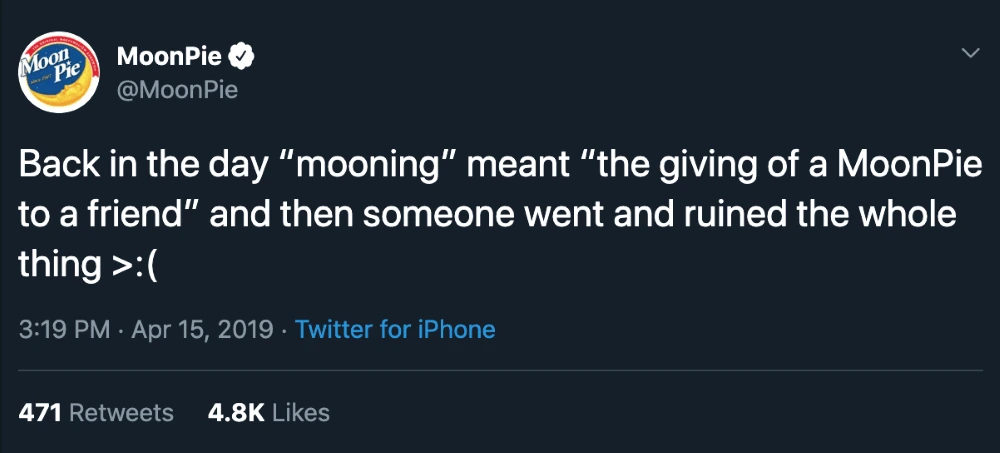
Source: Twitter
Your consistent brand voice is also archived for prospective customers who are using Twitter to research how you interact with your followers. Twitter’s open format leaves nothing to the imagination, and some have experienced the fallout when old, problematic tweets resurface at inopportune times.
5. TweetDeck lets your monitor Twitter for free
If you have a Twitter account, you also have access to TweetDeck. It’s a free tool that specializes in monitoring. Simply identify accounts, keywords or hashtags you want to follow, and watch as TweetDeck creates individual feeds for your selected parameters. This is an effective way to stay in the conversation, because you don’t have to use the main Twitter platform to search keywords one by one and possibly miss an important tweet.
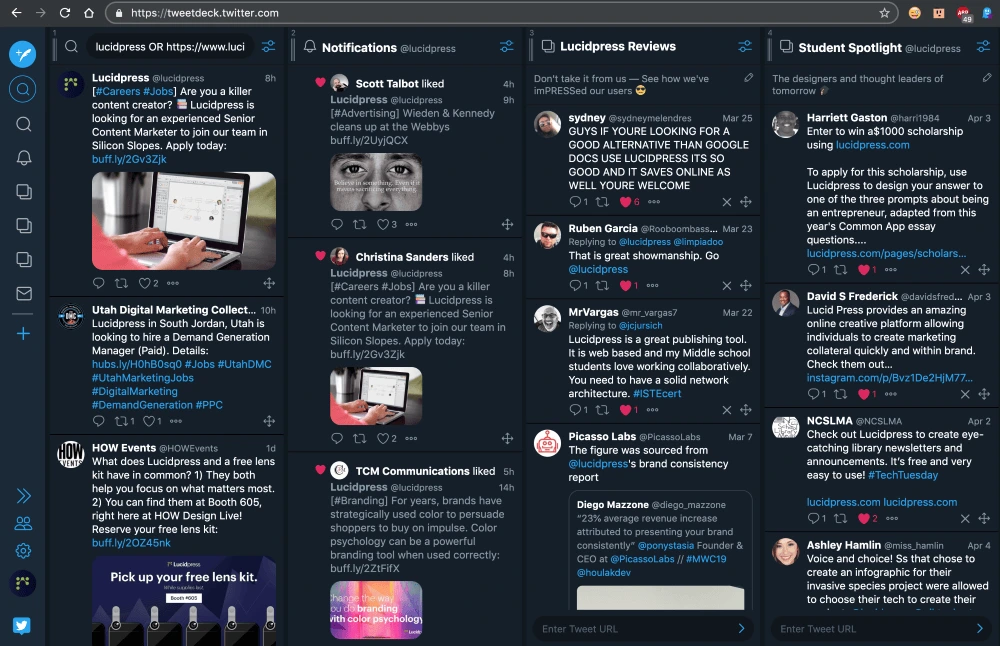
The Lucidpress TweetDeck
TweetDeck lets you watch your competitors’ activity and community all at once, which makes it an impactful tool for poaching customers. For example, if you see a user complain about a competing brand because you’re tracking their name as a keyword, you can reply and recommend your brand as a viable solution that addresses their pain points.
Keyword monitoring also keeps marketers in-tune with discussions about relevant industries, so future strategy can address industry topics. Rihanna’s company, Fenty Beauty, is popular for its vast array of makeup shades designed for all skin tones. By identifying a pain point—makeup is non-inclusive to people with darker skin tones—the company addressed it with real action and enjoys success because of it.
6. Influencers can boost your campaigns
In 2019, there’s no doubting the power of the influencer, a modern-day social media celebrity. Marketers have found that influencer campaigns yield an average return of around $7.65 for every $1 spent. However, Instagram is oversaturated with individuals pushing products, which makes influencer campaigns that much fresher on other social networking sites.
Twitter, in particular, has massive potential for marketers. That’s because there’s a 2x increase in purchase intent when consumers see tweets from both brands and influencers. Also, 49% of Twitter users responded that they rely on recommendations from influencers, and 40% have made a purchase solely based on a tweet from an influencer. The numbers don’t lie, and they show an opportunity marketers can’t find in many other places.
7. Your profile will drive traffic to your site
Social media profiles are the new homepage. [![]() ] As mentioned earlier, Twitter is the place to develop and showcase a brand voice, so users will often visit a brand’s Twitter profile to get a better feel for the brand. About half the time, that visit will inspire further research, namely due to the fact that 47% of the people who visit a Twitter profile also visit the website linked to that profile.
] As mentioned earlier, Twitter is the place to develop and showcase a brand voice, so users will often visit a brand’s Twitter profile to get a better feel for the brand. About half the time, that visit will inspire further research, namely due to the fact that 47% of the people who visit a Twitter profile also visit the website linked to that profile.
Marketers should keep in mind that brand voice should be consistent and seamless across channels, so a playful Twitter account shouldn’t lead to a landing page with overly serious language. Otherwise, consumers will end up confused and leave the page without converting.
8. Follower insights help you develop your follower persona
Twitter users are given native analytics within the platform, and they’re some of the best across social media sites. In particular, the Audiences tab helps marketers paint a picture of their average follower.
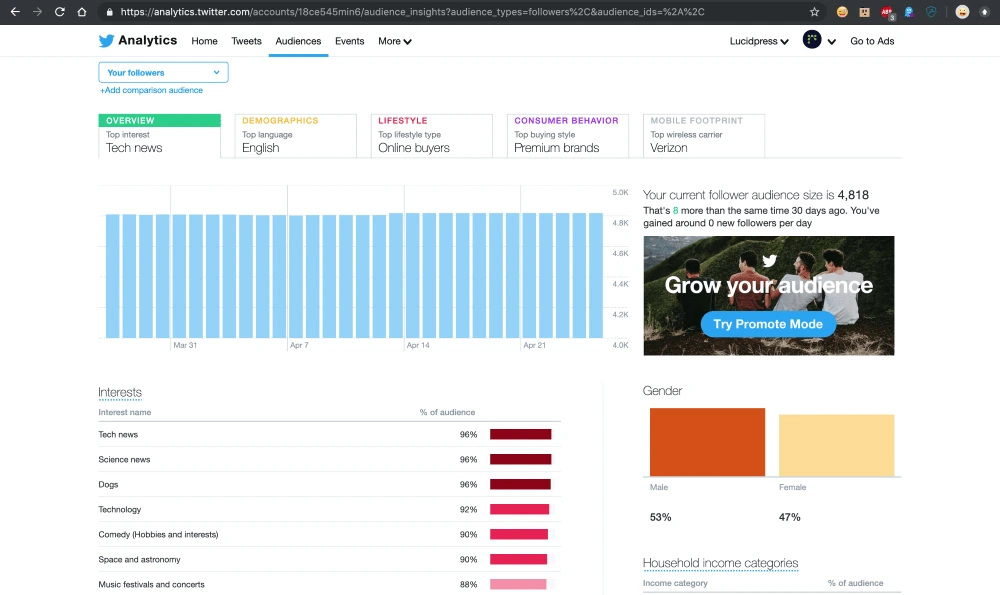
The Lucidpress Audiences tab
Audiences has four categories: Demographics, Lifestyle, Consumer Behavior and Mobile Footprint. The data delivers insight into your followers and their interests—as well as how they interact with brands, which is helpful to know before launching a campaign. With your follower persona in mind, you can aim directly for Twitter users who match the kind of people following you already.
9. Advertising spend is low & effective
Advertising on Twitter costs as little as one dollar per day, but its real strength is optimization. Twitter Ads guides marketers of all experience levels through the campaign creation process by suggesting parameters to maximize impact. Then, if the setting is selected, the platform will pace spending based on results to ensure marketers aren’t spending unnecessarily.
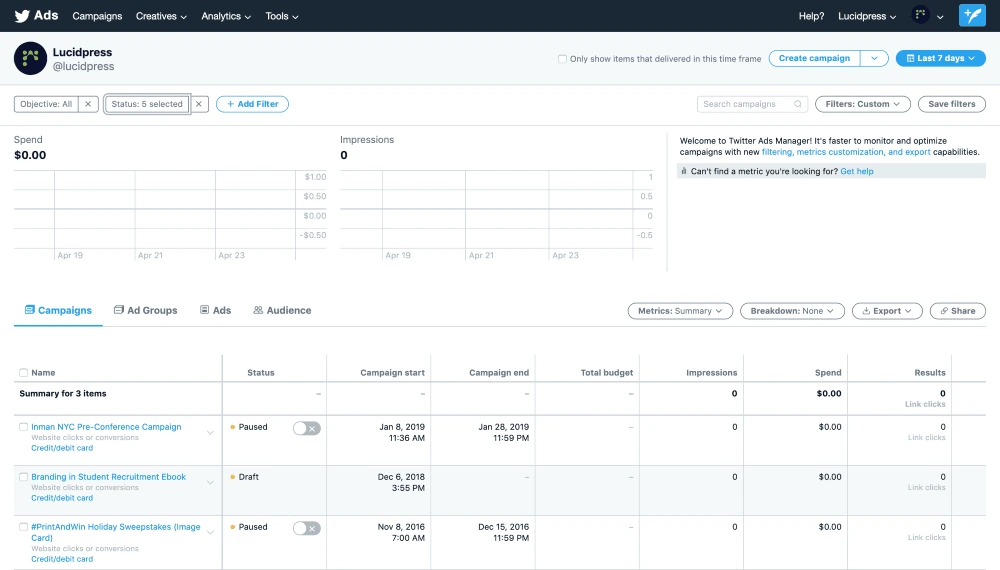
A heavily filtered version of Lucidpress Twitter ads (can’t give away all our secrets!)
As you gain experience, you can also experiment with A/B testing, using different campaign types or applying other settings. It’s customizable and incredibly user-friendly. The best part? Independent research shows that Twitter marketing campaigns can deliver 40% higher return on investment when compared to other media channels.
10. Community management is possible with branded hashtags
Hashtags are still the king of social media discovery tools, especially when marketers use branded hashtags. Created by brands to give consumers a way to share their experiences on social channels, branded hashtags comprise 70% of the total hashtag landscape.
Marketers can use these niche spaces to easily follow their brand communities online. Whether it’s to participate in a Twitter conversation or to find user-generated content for future tweets, there’s tremendous potential.
11. Anyone can go viral
One of the best parts of Twitter is its capability to spread a message like wildfire. Anyone who uses the platform regularly sees multiple tweets per day reach viral status because they’re funny, relatable or newsworthy. Those tweets can come from anyone, no matter how few followers they might have.
Brands can similarly go viral with a tweet, which immediately increases reach, traffic and conversions. All it takes is a well-timed post that resonates. The sky—or, should we say, the 280-character count—is the limit.
What are you waiting for?
Follow @lucidpress on Twitter today! Just kidding. …Mostly. Okay, here’s what we were actually going to say.
Twitter is a unique marketing channel with huge opportunities for brands looking for a new way to reach prospective customers. It’s not yet full of business accounts, and it has maintained the authenticity that’s lacking on other social media sites—which has resulted in a dedicated user base that’s tired of Instagram’s careful curation and Facebook’s fake news.
Marketers always need to have new tricks up their sleeve to adapt to the ever-changing landscape of digital advertising. They should not overlook Twitter if they want to make an impact. It’s perhaps one of the purest platforms left, and the possibilities are wide-open to incoming brands.
Ready to design your own branded Twitter content? Hop over to our free Twitter template gallery and get started!
Social media can help real estate agents find a wide audience, in the right area and at the right time.
In fact, according to the National Association of REALTORS 77% of real estate agents use social media. Facebook is by far the most popular platform in real estate, followed by LinkedIn and Instagram.
Related: Real estate marketing guide
Even with limited resources, savvy real estate agents can build meaningful relationships and earn more clients with social media.
How do you do it?
The sheer array of social media platforms and real estate marketing techniques seem overwhelming. Here are seven and a half practical tips to get you started in no time.
Social media for real estate tip #1: The basics
If you are already set up on social media, go ahead and skip ahead to the advanced tips below.
Facebook for real estate
To get started, set up a business page on Facebook. This is more professional than posting to a personal account and gives you access to useful business features such as page analytics and the ability to promote posts to your audience. Posts with images and video perform best on Facebook, so be sure to use compelling visuals with every post you create.
The Facebook algorithm favors posts that get a lot of engagement, so ask questions to drive comments or share content your followers will enjoy such as an upcoming local event, so they like and share it. If you’re just getting started and don’t have a large social media following yet, holding a contest to bring awareness of your real estate page is a great way to build up your follower count.
Instagram for real estate
Instagram is quickly becoming one of the most popular social media sites. As a visual platform, every post will need to be visually compelling. Use the caption that goes with the photo to provide additional details and include your contact information. A single Instagram post can be made up of a series of images, making it a great way to show photos of a new real estate listing.
LinkedIn for real estate
Update your personal profile and if you are running your own business, create a page for the business as well. LinkedIn provides a great opportunity to network with other real estate agents, connect with real estate brokerages and connect with current clients.
Social media for real estate tip #2: Start two-way conversations
A staggering 94% of millennial homebuyers are taking their search online. This creates incredible opportunities for real estate agents to connect with them there—but only if they truly understand their audience’s motivations.
It’s tempting for real estate agents to promote their business and new home listings relentlessly on social media. After all, isn’t that what those platforms are for?
Not exactly. For potential homebuyers, constant, in-your-face promotion has minimal appeal. If they wanted endless advertisements, they could just flip open a magazine or turn on the TV. Treating them this way shows a fundamental lack of understanding about your target audience.
The vast majority of potential homebuyers are searching for information. They have questions. If they’re considering buying for the first time, they’re probably intimidated, too.
Savvy real estate agents use social media to walk everyone through the process, creating stronger bonds than the constant sales pitch approach. Instead of just posting endless promotional content (a one-way broadcast), you open up two-way conversations. The audience becomes a key creator of the shared experience.
This takes on many forms. It might be searching Twitter hashtags and offering real estate advice to those in your local area. Tomorrow it might be hosting a Q&A session on Facebook Live. Next week it might be something as simple as asking a question in your newest listing photo caption on Instagram. Whenever you can, invite your audience to participate in the conversation.
Yes, you can still find opportunities to promote your real estate listings. But, a commitment to being relentlessly helpful builds trust and authentic relationships.
Social media for real estate tip #3: Choose your social media platforms wisely
Social media is fast-paced, chaotic, and changing constantly. It’s easy to get overwhelmed by the sheer number of platforms.
Real state agents new to social media might feel the pressure to “be everywhere.” Pressed for time already, they drive themselves crazy trying to maintain a presence on a dozen different accounts.
This approach actually leaves them worse off than before. Because they’ve spread themselves so thin, it’s impossible to get the traction needed to build an audience on any platform.
What could you do instead?
Start by taking a deep breath. Acknowledge there are tons of platforms out there—and a lot to learn. And accept that you’ll see the best results for your real estate business by focusing on just a few right now. Begin the journey with proven social networks like Facebook, Twitter and Instagram.
Which platforms deserve the majority of your focus? A lot depends on your audience. Beyond the overall popularity of the platform, consider where your target market spends their time online. You wouldn’t want to launch a Snapchat strategy when trying to sell retirement condos—the demographics there skew too young. If you’re selling commercial real estate, consider connecting with successful professionals and industry organizations on LinkedIn.
Do some preliminary research to pinpoint where your audience is most engaged. Other real estate agent’s and brokerages accounts can be a great place to start. Using those insights as a guide, narrow your focus to a few platforms as availability allows… which brings us to the next point.
Social media for real estate tip #4: Post consistently (and strategically)
A successful social media for real estate strategy is a lot like a successful relationship-building strategy in real life. You need consistent contact—and interactions that provide value and motivate people to keep coming back.
The goal: create enough interactions for your audience to get to know you as a real estate agent without overwhelming them to the point they tune you out.
This is a delicate balance to maintain, but the good news is it’s something you can always adjust as you go. Feedback from your networks (whether you’re gaining or losing followers, their engagement, etc.) will tell you if you’re headed in the right direction.
You can use social media software to schedule posts beforehand. This gives you the freedom to meet with clients, work open houses, and attend closings all while building your presence automatically. It’s easy to post multiple times a day this way.
Posting frequency is one thing, but you also have to consider the nature of the content itself. Most content breaks down into three different types:
- Time-sensitive/promotional. These posts advertise new properties on the market, open houses, or your brand in general. Think of listing photos, tweets urging prospects to give you a call, and virtual tours with Facebook livestreams or 360-degree photos.
- “Evergreen” how-to or informative. This content answers questions, shares tips, or finds alternative ways to provide value. It’s just as valuable a year from now as it is today. This could be decorating tips, a checklist to help you see how much house buyers could afford, or cool DIY renovation project ideas.
- Fun or entertaining. This content might not be directly related to real estate, but it’s a great way for you to showcase your personality. It might be a review of a new restaurant in town, a heads-up about traffic on the way home, or even those viral cat photos. Social media just gets prospects in the door. It’s your personality and expertise—real-life relationship skills—that will close the deal.
Understand the goal of each post you make, and mix things up to engage your audience and keep them coming back.
Finally, remember that there’s no need to create all this content yourself. Supplement your own efforts by sharing, retweeting or linking to other great content in the real estate industry. Your clients are a great content source—whether it’s sharing a quote from their testimonial or a photo of them toasting a new home.
Social media for real estate tip #5: Incorporate storytelling
Every great real estate agent knows how to tell a compelling story. Include that storytelling element in the social media content you create.
Some examples:
Talk about the neighborhood. When posting a new real estate listing, do more than talk about the price and features of the home. Create a compelling story by including details about the neighborhood. Help the potential buyer picture what it would be like to actually live in that home.
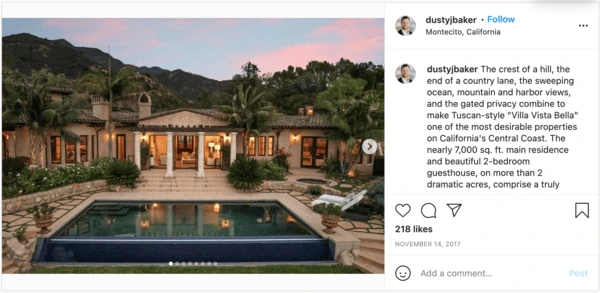
A post shared by Dusty Baker (@dustyjbaker) on Nov 14, 2017 at 10:46am PST
Include client testimonials. Ask happy customers if they’d be willing to create a video testimonial. Testimonials make compelling stories that help build trust with your audience.
Share milestones. On LinkedIn, share milestones of your real estate business. This could be anything from 10 years in business to updated branding or a new website.
Using storytelling in your social media campaigns will help drive greater engagement and build trust with your audience.
Social media for real estate tip #6: Use great, on-brand visuals
Social media has transformed the way realtors and agencies connect with potential buyers and clients. Because of the visual nature of house shopping, it’s easier than ever for people to go online and find examples of their dream homes.
Ideally, this should make real estate marketing faster and easier… but unfortunately, that’s not always the case. If you’re unfamiliar with Photoshop or other desktop publishing software, it can be difficult and time-consuming to create content specially for each social media site.
Instagram is a completely visual platform, which makes it perfect for marketing real estate. Photos are nice to have, but it can leave buyers confused as to what to do next—”Is this property for sale or just for show?” they might be wondering. By using this square photo collage, you can show off multiple views of the property and guide folks toward the next step: contacting you for a walkthrough or an offer.

Speaking of visual platforms, Pinterest is a haven of gorgeous home ideas, which makes real estate a natural fit. Pinterest users build boards to house (heh) their pins, all of which come from various sources. It’s easy for your name or website to get lost in the shuffle—unless your images themselves are clearly branded. That’s what makes this perfectly sized Pinterest template a cut above the rest. The majority of space is reserved for eye candy, but all the important property details are right there, too.

When you want to get a new listing out fast, no platform is better than Twitter. Not only can you keep your followers in the know, you can also target new audiences with paid promotion to get the most mileage. Because things move so quickly on Twitter, it’s important to design posts that are easy to digest. This template is oriented horizontally; it’s compact and looks great on both desktop and mobile.
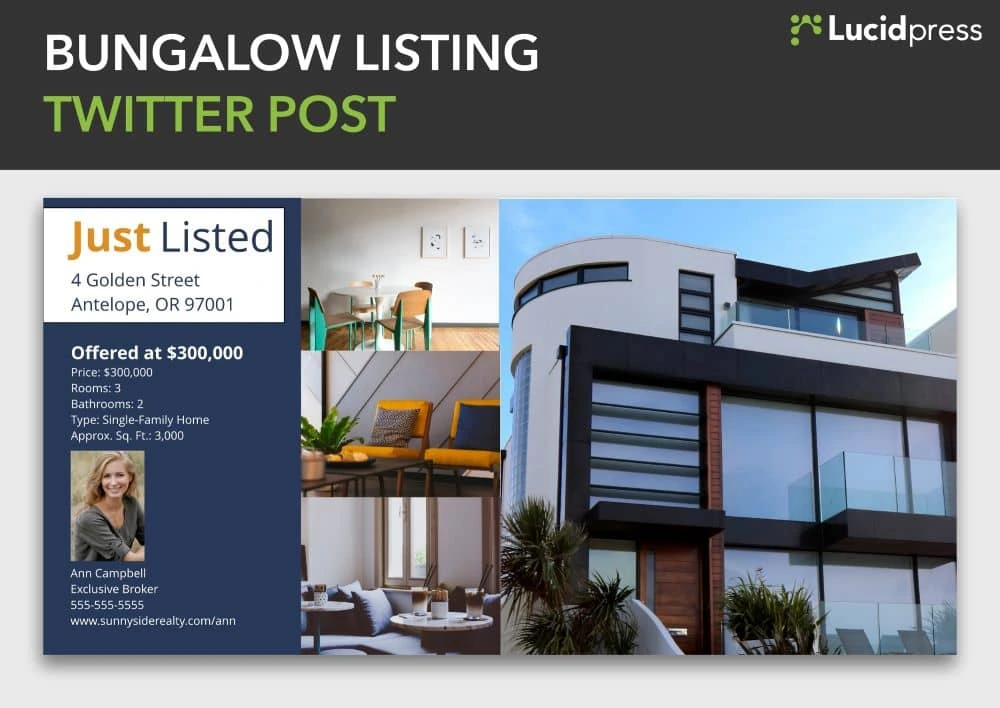
Social media for real estate tip #7: Remember your past clients
Social media is a great tool for realtors to build relationships and land clients. But, that’s only part of its appeal. It can also help maintain relationships you’ve already developed.
What happens when those closing papers are signed? Clients feel a rush of adrenaline, but after a few months, everyday life creeps back in. An incredible 70% of homeowners can’t even remember their real estate agent’s name one year after closing.
It’s a shame to have those relationships slip away after you’ve spent so much work building them. With a little social media love, it’s much easier to maintain them. That way, when clients are ready to move again or recommend a realtor to family or friends, you’ll be the first person who comes to mind.
How can you do this on social media?
Release a steady stream of that evergreen content we mentioned earlier. Brainstorm all the things you wish you knew when you moved into a home. Is it design inspiration? Checklists to get organized? Ways to prepare for the winter or save money on utility bills?
You can also broaden your content from real estate itself. Now that your client has moved, they’re living, working and integrating into the community. They might be interested in that new restaurant down the road. Or the best summer camps to send their kids. You can become their go-to source for all things local.
Social media for real estate tip #71/2: Measure and keep learning
You’re sending emails to clients, working open houses, and putting out yard signs. (Not to mention trying to keep up with your own personal life.)
You don’t have endless hours to pour into social media that isn’t paying off. How are your tweets performing compared with your Pinterest posts? Should you be posting on Facebook or focusing on Instagram?
These are the questions that can frustrate you to no end. Instincts might give you some indication, but measuring will let you know for sure.
Fortunately, it’s never been easier to collect data on social media performance. It’s easy to see which posts get the most engagement in terms of likes, retweets and comments. But, if you’re looking to see what’s really moving the needle in terms of sales, why not create unique landing pages for each platform?
A landing page simply directs visitors whenever they’re interested in contacting you, seeing a new listing, and so on. Tailoring them for each social media platform allows you to track where leads come from. You can also find out a lot more about each user’s interactions with your brand and their path to becoming a client.
Keep an eye out on which platforms, campaigns and topics perform best. As long as you keep tracking your analytics and tweaking your strategy, it will gradually get more effective. This optimization process never ends, but the payoff increases over time.
Over to you
Social media has become an essential piece in every realtor’s marketing toolkit. Thankfully, it doesn’t have to be overwhelming anymore. Apply the tips above while launching your real estate marketing strategy, and you’ll build an impressive audience, engage them, and bring in more business.
Kickstart your next social media campaign with our free templates for real estate.
With 330 million active users monthly, Twitter can be a goldmine for business marketing. Celebrities, journalists and politicians flock to this powerful social network daily to strut their stuff and engage with followers. And it’s become a hub for brands who use Twitter as a clearinghouse for customer service concerns and boost brand reputations. However, if you haven’t figured out how to use Twitter for business marketing, you’re not alone.
Tweets fly thick and fast on the platform (nearly 500 million a day), so it’s easy to lose your way in the buzz of trending hashtags. Before jumping into the fray, we recommend developing a Twitter marketing strategy that centers your organization’s priorities — from brand awareness to boosting conversions; Twitter is a fantastic tool to reach your target audience if you leverage it effectively.
How to create a Twitter marketing strategy
Not all social media is created equal. Your Twitter marketing strategy should play to the platform’s strengths while centering around your business goals. Follow these steps to solidify your Twitter marketing strategy and start building a solid foundation for your brand’s social media presence.
Audit your accounts
Whether your brand has a handle you’ve used a handful of times or a patchwork of accounts, take stock of your Twitter presence. Make a list of:
- The profiles associated with your organization
- Who manages them
- What these profiles are currently being used for
Pay attention to metrics like how often the account tweets and how many followers it has. If an account isn’t verified yet, now is a good time to reach out to the Twitter verification team.
Keep an eye on competitor accounts
Once you have a good sense of your own social media presence, it pays to take a peek at the competition. Look for the good, the bad and the ugly in terms of engagement on the platform, as well as reach and whatever else you can learn from any missteps made. Keeping your finger on the pulse of industry leaders can serve as inspiration for how to refresh your presence on the platform.
Articulate your goals
A commitment to improving your brand’s Twitter marketing strategy should start with SMART goals that are specific and measurable. While you may be tasked with a vague sense of improving the brand’s social media reach, setting goals requires quantifying what success looks like. Make sure the goals you set are reasonable and actionable, and break down the strategies you’ll use to get there.
Assign responsibility
It doesn’t make sense to drive traffic to your Twitter account if no one is going to tend it. Discuss who is responsible for monitoring the account and set expectations for response time. Twitter is a fast-paced platform, and complaints can snowball into serious PR issues. Every engagement is your brand’s opportunity to build trust in the public marketplace.
Set some guidelines
If you don’t already have social media guidelines, now is a good time to define them. Communication between various members of the team attending your Twitter account should be consistent and transition seamlessly. Discuss how handoffs with the customer service team will occur and protocols for addressing the most frequently surfaced concerns.
Find your voice
Leverage your brand style guide to figure out what your social media voice sounds like. Set guidelines not only for when you’ll engage with followers but how. While you might opt to use humor or keep it more buttoned-up, the most critical piece of advice for successful social media engagement is to be human. Whether someone is a fickle Twitter follower or devoted customer, people appreciate brands that strive to be authentic and sincere.
Create a content strategy
In the same way that you create a content strategy for your blog or website, you should create a strategy for your Twitter content. Focusing on customer success stories, amplifying promotions or providing industry insights are all ways Twitter content can communicate your brand’s priorities. Studying buyer personas may also help you to flesh out what content your audience craves.
Plan a Twitter content calendar
Having goals for your Twitter marketing strategy is a start, but taking action is paramount. Establishing a social content calendar enables you to control the timing of your messaging for maximum impact and implement effective campaigns across all your channels. There are several third-party services that can help manage campaigns in one place and schedule tweets in advance.
Measure, analyze and adjust
Once you have a Twitter marketing strategy solidified, start measuring your progress. Fortunately, Twitter puts much of the data you’ll need at your fingertips. Here are just a few of the metrics Twitter analytics provides.
- Engagement: You can click to see engagement on each tweet or access overall engagement metrics for your account from the main menu.
- Impressions: Impressions are a measurement of how many people have seen your tweet and the reach of your content.
- Hashtags: Twitter measures the popularity of certain hashtags among your followers, so you know what to amplify.
- Top tweets: See your top-performing tweets, so you know what’s working and can tweak your approach to gain better traction.
If you’re using Twitter ads, you’ll get additional analytics and advice on how to improve performance in the Twitter Business Center.
Twitter marketing best practices you should follow
While there’s no single approach for using Twitter for business marketing, there are some best practices brands follow to make the most of the platform. Here are some ways to get your Twitter handles churning out social media buzz.
Brand your profile
From the images you display to the website your account connects to, every piece of your Twitter profile should align carefully with your brand. Twitter allows users to customize profiles, so make the most of that valuable real estate with content creation tools like the Lucidpress Twitter header template.
Leverage hashtags
Every social media platform has unwritten rules about hashtags. On Twitter, the home of hashtags, the motto is to use them sparingly. Branded hashtags are a great way to amplify campaigns, but sprinkling in too many will trigger Twitter’s spammy senses. Using popular hashtags also helps your brand ride the wave of Twitter trending topics and expand organic reach.
Engage, engage, engage
Gaining more followers is the name of the game on any social media platform, but it’s especially important on Twitter. However, instead of approaching Twitter as an opportunity to build clout, think of it as a chance to build community. The more you engage in the replies or the discussions happening in your mentions, the more you’ll build trust.
Mix it up with media
While Twitter might not be as visually appealing as platforms like Instagram, users still love dynamic tweets with high-quality images, GIFs, and videos. Including a mixture of media creates “shareable” content and enables you to do more with Twitter’s 280 character limit. In some cases, a picture really is worth a thousand words.
Want to create branded graphics for your tweets that’ll pop-off with your audience? Use Lucidpress Twitter post templates.
Promote and advertise
Twitter offers a few different ways for brands to advertise. One method is through promoted tweets, where businesses pay a monthly fee to promote tweets to a targeted audience. The other method is through Twitter Ads, which leverages keyword or timeline targeting. Both promotion methods can be great ways to elevate your brand profile and build a following while driving conversions.
Keep these helpful tools handy
Twitter does offer other bells and whistles worth discussing. One is Twitter lists, which weed through the chatter by aggregating tweets from accounts you select. Creating lists is a clever way to curate content and amplify trends within your industry. Twitter Moments also offers customization by allowing users to select tweets from their own timeline and mix in tweets from other accounts to create a comprehensive take on a topic.
Take the time to listen
Instead of dropping into your brand’s mentions or replies sporadically, set up scheduled interactions with followers by soliciting feedback through Twitter polls or hosting a Twitter chat. Many brands find Twitter chats are more successful if organized around a theme or hashtag and scheduled consistently from week to week.
Know that challenging interactions are par for the course
Twitterverse is notorious for broadcasting customer service mishaps. And your response to those complaints can make or break your brand’s reputation. Once an incident starts trending, it can be hard not to watch the train wreck. That’s why it’s critical to tend your mentions closely and respond quickly. Decide whether it’s a conversation you want to have in a public forum and direct the customer to your direct messages for a speedy resolution.
Whether you’re pruning a Twitter presence or nourishing a neglected handle back to life, you don’t have to go it alone. Lucidpress is here to help with streamlined Twitter templates and resources.
Try these Lucidpress Twitter templates to create a buzz-worthy, branded Twitter presence.